THIS PAGE FIRST POSTED 1 FEBRUARY 2017
LAST MODIFIED Tuesday 17 December 2024 10:41
George Strong and family
Dr GRAEME SKINNER (University of Sydney)
THIS PAGE IS ALWAYS UNDER CONSTRUCTION
To cite this:
Graeme Skinner (University of Sydney),
"George Strong and family",
Australharmony (an online resource toward the early history of music in colonial Australia):
https://sydney.edu.au/paradisec/australharmony/strong-george-and-family.php; accessed 25 December 2025
STRONG, George (senior)
Tailor, ? theatre musician
Born Dublin, Ireland, (? c.1801), c. 1804/5
Married Catherine Jane HAMILTON (c.1805-1846), c. 1825/6
Arrived Sydney, NSW, 18 November 1833 (steerage passenger per Edward Coulson, from Liverpool, via Hobart Town)
Died Sydney, NSW, 30 January 1855, "aged 55"
https://trove.nla.gov.au/search?l-publictag=George+Strong+d1855 (TROVE tagged by Australharmony)
STRONG, George
Violinist, theatre musician, composer
Born Dublin, Ireland, (1822, 1824), c.1826/7 (son of George STRONG senior and Catharine HAMILTON)
Arrived Sydney, NSW, November 1833 (steerage passenger per Edward Coulson, from Liverpool, via Hobart Town)
Married Elizabeth EDWARDS (1828-1875), Sydney, NSW, 1 September 1848
Died Sydney, NSW, 1878
https://trove.nla.gov.au/search?l-publictag=George+Strong+d1878 (TROVE tagged by Australharmony)
STRONG, Emily = CLICK HERE
Amateur vocalist, pianist
Summary
George Strong, violinist and composer, was the son the Sydney tailor, George Strong (1799-1855), who from the 1830s onward also worked as a theatrical costumier in Sydney, and for a short period also Adelaide.
Though George junior was later described at least once as a native of the colony, he was almost certainly born in Ireland, and reportedly 6 years of age when he arrived in Sydney with his parents in the ship Edward Coulson, on 18 November 1833. If not actually native born, he was obviously largely trained as a musician in the colony.
A 'Mr. Strong" first appears listed as an orchestra member in Isaac Nathan's oratorio in St. Mary's Cathedral, Sydney, in June 1841, probably George junior, then aged in his mid teens.
Both Georges were certainly involved in Sydney theatre by 1843. In a single advertisement for the Royal City Theatre in May, for instance, one "Mr. Strong" is listed as a member of the orchestra, and the other as being in charge of "The Dresses"; then in August, in the City Theatre's published accounts, Mr. Strong was paid £1 for "stage music".
Young George was again in the orchestra for the first complete Sydney performance of Handel's Messiah on 23 December 1845, and he was billed as a member of John Deane junior's orchestra for a concert by the Sydney Harmonic Club in June 1846. In June 1847, on a Royal Victoria Theatre program that also included the Sydney premiere of Mozart's The marriage of Figaro (in Henry Bishop's English adaptation), "Mr. G. Strong" was specially billed as performing a violin solo.
George also played outside the theatres, appearing for instance, in September 1852, in the saloon of the Royal Hotel, in George Street, at a benefit concert for Howard's Serenaders, playing a violin solo "introducing airs from Sad Sea Waves, Auld Robin Gray, and Savourneen Deelish".
When the new Prince of Wales Theatre, on the corner of Castlereagh and Market Streets, opened in March 1855, John Gibbs was billed as leader of the orchestra, while at the Victoria Theatre, John Winterbottom took over. However, by December, both the Victoria and Prince of Wales had come under single the management of J. G. Griffiths, and the orchestral forces appear to have been shared between the two. For major events, such as Anna Bishop's Sydney premiere at the Prince of Wales on 22 December 1855, Gibbs directed the orchestra. However, for the general run of performances, George Strong was - for at least a short time - left in charge at the Prince of Wales. Earlier that month, for instance, at a benefit for the actor-singer Frank Howson and the orchestra:
At the conclusion of the first part, a violin solo, by Mr. George Strong, is announced. Mr. Strong is a native of the colony [sic], and has for some time led the orchestra at this theatre in a highly creditable manner; he is an instrumental performer of no mean capacity, and will, no doubt, sustain the reputation he gained by his previous solo performances a few years ago.
This may well have been the peak of George's career. Having been in demand for the past decade as one of the better of Sydney's relatively small cohort of professional violinists, by the mid-1850s he was probably finding himself seriously outclassed by high-profile new arrivals. The buoyant gold rush economy had lured to Sydney violin soloists like Miska Hauser and Henri Herwyn, and other probably more talented orchestral musicians like George Peck, Charles Eigenschenck, and the young John Thomson Hall. In terms of technical ability and violin showmanship, Strong may no longer have been able to compete.
Strong's name is notably absent from the orchestra for the Musical Festival held in the Great Hall of the University of Sydney in 1859. "George Strong, of St. Leonard's, musician" was listed as insolvent in April 1861, but allowed to retain his "household goods and wearing apparel". This might have contributed to an act of delinquency on the part of George's son, also George, who in was fined in the Water Police Court in June 1861 for viciously beating a pony. Adding further to Strong's sorrows, young George died in 1865.
After 1861, George Strong's name disappears from the musical record, though, for all we know, he may well have continued teaching and playing the violin for balls and dances. He died, at his residence in Mitchell Street, St. Leonards, on 29 October 1878, aged 54 years.
Documentation
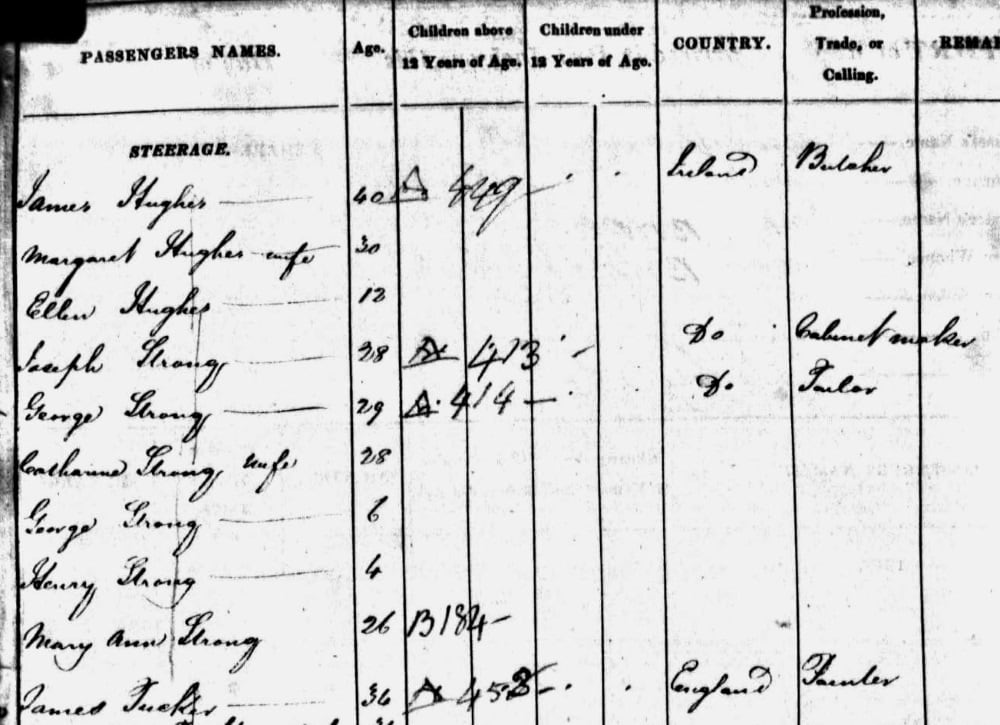
New South Wales, unassisted immigrant passenger lists, 1826-1922; 1833, 18 November, Edward Coulson; State Archives and Records New South Wales (detail above)
Joseph Strong / 28 / [Ireland] / Cabinet maker
George Strong / 29 / [Ireland] / Tailor
Catherine Strong wife / 28
George Strong / 6
Henry Strong / 4
Mary Ann Strong / 26
"SHIPPING INTELLIGENCE", The Sydney Herald (21 November 1833), 2
http://nla.gov.au/nla.news-article12848208
From Liverpool via Hobart Town, same day [18 November], having left the former port on the 15th of June, and the later the 6th instant, the barque Edward Coulston, 340 tons, Captain Joseph Hammond, with merchandize. Passengers . . . Joseph Strong, cabinet-maker, George Strong, tailor, Catharine Strong, George, Henry, and Mary Ann Strong . . .
30 June 1841, oratorio, St. Mary's Cathedral
[Advertisement], Free Press and Commercial Journal (19 June 1841), 4
http://nla.gov.au/nla.news-article228246683
ORATORIO. MR. NATHAN has the honour to announce, that on WEDNESDAY, June 30, 1841, will be given, at St. Mary's Cathedral, a Grand Oratorio, Consisting of a selection of sacred music . . . Instrumental Performers - Mrs. Prout, Mr. Wallace, Mr. Leggatt, Mr. Deane, Mr. John Deane, Mr. Edward Deane, Mr. William Deane, Mr. Wallace, sen., Mr. O'Flaherty, Mr. Portbury, Mr. Sippe, Mr. Meyer, Mr. Strong, and Mr. Walton; with the kind assistance of the gentlemen amateurs from the Cecilian Society, and (by permission of Colonel French) of the Band of the 28th regiment. Leader, Mr. Wallace; Conductor, Mr. Leggatt. The whole under the entire management of Mr. Nathan, who will preside at the organ . . .
ASSOCIATIONS: Isaac Nathan (director); Spencer Wellington Wallace (leader); Thomas Leggatt (conductor); Deane family (string players); Spencer Wallace senior (string player); Henry Charles O'Flaherty (violinist); Benjamin Portbury (cellist, bass player); George Sippe (cellist); Humphrey Walton; Cecilian Society; Band of the 28th Regiment
[Advertisement], Australasian Chronicle (20 November 1841), 3
http://nla.gov.au/nla.news-article31733460
ROYAL VICTORIA THEATRE.
MR. SIMES'S (Acting Manager) BENEFIT. -
Monday, November 22nd, 1841 . . .
The whole to conclude with the Laughable Burletta called the
THE DANCING BARBER; OR, THE MISTAKES OF A FANCY BALL . . .
. . . gentlemen of the staff, Mr. Holdfast and Mr. Strong . . .
"INSOLVENCY PROCEEDINGS", The Sydney Morning Herald (18 August 1842), 2
http://nla.gov.au/nla.news-article12425496
In the insolvency of Luigi Dalla Case . . . George Strong, called by Mr. Dillon, deposed: I was employed as tailor at the Olympic Theatre. I cannot say whether any of the wardrobe has been taken away. I think there is about a dozen of white ostrich feathers, and a great number of other articles belonging to the theatre, missing; they were missing before Dalle Case's insolvency, and before I made out this inventory. I used to give up the key every night to the Signor. Cross-examined by Mr. Nichols: other persons had access to the wardrobe as well as the Signor . . .
ASSOCIATIONS: Luigi Dalle Case [sic]
"ROYAL CITY THEATRE, MARKET-STREET", The Sydney Morning Herald (17 May 1843), 2
http://nla.gov.au/nla.news-article12424212
ROYAL CITY THEATRE, MARKET-STREET. PROPRIETORS, MESSRS. SIMMONS AND BELMORE . . .. have the honour to announce their OPENING NIGHT for SATURDAY, the 20th MAY . . .
The Orchestral Selections for the evening which will be performed previous to the several Pieces, and between the Acts, include Haydn's Symphony, No 2; Mozart's Overture to L'Irato; Rossini's Overture to Il Barbiere di Seviglia; and Brilliant Arrangement of Strauss Valses.
The Band comprises the following instrumental Performers - Mr. S. Wallace, Mr. Leggatt, Mr. Walton, Mr. Wallace, senior; Mr. Portbury, Mr. Walker, Mr. Adams, Mr. Wright, Monsieur Gautrot, Mr. Wilson, Mr. Strong, and Mr. Andrews.
ASSOCIATIONS: Joseph Simmons (actor, vocalist, manager); Joseph Gautrot (violinist)
"TO THE EDITOR", The Australian (11 August 1843), 2
http://nla.gov.au/nla.news-article37116174
. . . the following items are some, but not all of the expenses incurred;
they are published for public information;
Messrs. Simmons & Belmore, for house 10 0 0
Gas Company, for lighting, &c. 1 4 0
The Misses Jones, for acting 2 10 0
Mrs. Lewis, for acting 1 10 0
Mr. Strong, for stage music 1 0 0
Sun Office, for tickets and bills 3 11 6
Scene shifters 0 12 6
Managing ditto 0 10 0
Bill Sticker, and for cleansing Theatre &c 0 7 6 . . .
"KIDNAPPING", The Australian (12 December 1844), 3
http://nla.gov.au/nla.news-article37126312
GRAND ORATORIO,
AT THK ROYAL VICTORIA THEATRE, ON THE 23RD DECEMBER . . .
The Committee of the " Sydney Commercial Reading Rooms and Library have much pleasure in intimating that the arrangements for the performance of
HANDEL'S ORATORIO OF THE MESSIAH,
with Mozart's additional accompaniments, are now completed,
and that the whole of the professional talent of the colony has been selected for the occasion,
assisted by a large number of Vocal and Instrumental Amateurs,
who have readily come forward to aid in bringing out this sublime composition on a scale of unrivalled grandeur and magnificence.
CONDUCTOR - MR. JOHNSON.
LEADER - MR. S. W. WALLACE.
ORGAN - MR. W. JOHNSON.
PRINCIPAL VOCAL PERFORMERS - Mrs. Bushelle, Mrs. Stirling, Mrs. Gibbs, Madame Carandini, Mrs. Wallace, Miss Hincksmann, Miss Touhey,
Mr. Howson, Mr. J. Howson, Mr. Waller, Signor Carandini, Mr. Worgan, Mr. Griffiths, Mr. Salter, &c., &c.,
assisted by a large and efficient chorus.
PRINCIPAL INSTRUMENTAL PRRFORMERS. -
Mr. S. W. Wallace, Mr. Gibbs, Mr. Deane,
Mr. J. Deane, Mr. E. Deane. Mr. W. Deane, Mr. F. Deane, Mr. O'Flaherty, Mr. Gearing,
Mr. Friedlander, Mr. Walter, Mr. Wilson, Mr. Strong, Mr. Westropp,
assisted by numerous amateurs; and, by permission of Colonel Jackson,
THE SPLENDID BAND OF THE 99TH REGIMENT . . .
ASSOCIATION: James Johnson (conductor); William Johnson (organist); Zachariah Westrop (flute player); William Friedlander
[Advertisement], The Sydney Morning Herald (24 June 1846), 1
http://nla.gov.au/nla.news-article12888039
AUSTRALIAN HARMONIC CLUB
CONCERT.
AN AMATEUR CONCERT in aid of the Funds of the Sydney Infirmary and Dispensary,
UNDER THE PATRONAGE OF HIS EXCELLENCY SIR MAURICE O'CONNELL, AND LIEUT. COLONEL BLOOMFIELD,
Will take place THIS EVENING, WEDNESDAY, 24TH JUNE,
At the City Theatre, Market-street, (which has been kindly lent for the purpose)
on which occasion, in addition to the amateur talent, by which the performances at the
monthly concerts of the Club have been principally sustained, they will be assisted by the
following members of the profession, viz.:
VOCAL - Madame Carandini.
INSTRUMENTAL - Mr. John Deane, (leader to the Club), Messrs. J. P., E., and W. Deane,
Mr. Friedlander, Mr. Strong, and Mr. Guerin.
The Orchestra will be completed by the Instrumental Amateurs of the Club.
And by the kind permission of Colonel Bloomfield, the excellent Band of the 11th Regiment . . .
"DEATH", The Australian (22 December 1846), 2
http://nla.gov.au/nla.news-article37131976
STRONG, Mrs. Catherine, at her residence O'Connell-street, on the 20th Instant, aged 43 years.
[Advertisement], The Australian (26 June 1847), 2
http://nla.gov.au/nla.news-article37130017
ROYAL VICTORIA THEATRE. UNDER DISTINGUISHED PATRONAGE. FOR THE BENEFIT OF MR. AND MRS. GIBBS . . . ON MONDAY EVENING, JUNE 28, 1847, will be produced, the admired Opera, entitled The MARRIAGE OF FIGARO; OR, THE FOLLIES OF A DAY. With the whole of the Original Music, composed by Mozart, adapted to the English Stage by Sir Henry R. Bishop, and arranged for this Orchestra by Mr. Gibbs . . . [between the pieces] SOLO VIOLIN, - MR. G. STRONG . . .
ASSOCIATIONS: John Gibbs (leader of the orchestra); Eliza Gibbs (vocalist, actor)
27 January 1848, departure of George Strong senior, for Adelaide, with John Lazar
"CLEARANCES", The Sydney Morning Herald (25 January 1848), 2
http://nla.gov.au/nla.news-article12898339
"DEPARTURES", Sydney Chronicle (29 January 1848), 2
http://nla.gov.au/nla.news-article31755316
January 27. - Dorset, brig, 82 tons, Captain Walsh, for Adelaide. Passengers, - Mr. and Mrs. Lazar, two daughters and son, Mrs. Calvert and daughter, Mr. George Strong, Mr. Renton, and Mr. Murphy.
ASSOCIATIONS: John Lazar (actor, manager) and family
"MARRIED", The Australian (7 September 1848), 2
http://nla.gov.au/nla.news-article37133096
STRONG, Mr. George, of Sydney, to Elizabeth, eldest daughter of Captain Edwards, of Middle Harbour, by special license, by the Rev. Dr. Fullerton, on the 1st Instant.
"MARRIAGE", Sydney Chronicle (16 September 1848), 10
http://nla.gov.au/nla.news-article31757386
In this City, on the 1st instant, by special licence, by the Rev. Dr. Fullerton, Mr George Strong, (Professor of the Violin ) to Elizabeth, eldest daughter of Captain Edwards, of Middle Harbour, near Sydney.
ASSOCIATIONS: Captain John Edwards (1789-1861); James Fullerton (Presbyterian minister)
[Advertisement], South Australian Gazette and Mining Journal (15 February 1849), 2
http://nla.gov.au/nla.news-article195937121
NEW QUEEN'S THEATRE, LIGHT-SQUARE. FOR THE BENEFIT OF MISS LAZAR, THIS EVENING (Thursday), February 15th . . . The entertainments will commence with Rossini's opera . . . CINDERELLA; or, The Fairy and the Glass Slipper, For which purpose the orchestra will be considerably augmented and LED BY MR. LEE . . . Scenery, machinery, and transformations by Mr. Douglass. Dresses by Mr. Strong. Music, arranged for this orchestra, by Mr. Richards . . .
"ROYAL VICTORIA THEATRE", The Sydney Morning Herald (12 November 1851), 2
http://nla.gov.au/nla.news-article12931983
FOR the JOINT BENEFIT of the MEMBERS OF THE ORCHESTRA, who respectfully solicit a share of public patronage. TO-MORROW EVENING, NOVEMBRR 13, WILL be performed, the Drama of THE RED LANCE; OR, THE MERRIE MEN OF HOXTON . . . [between the pieces] "My Father's Grave," Miss S. Flower. Solo, Air, with variations, Mr. G. Strong . . .
ASSOCIATIONS: Sara Flower (vocalist)
[Advertisement], Empire (20 September 1852), 1
http://nla.gov.au/nla.news-article60137905
HOWARDS' SERENADERS . . . 192ND GRAND EVENING . . . BENEFIT OF MR. E. W. PIERCE, FLAUTIST. THIS EVENING (Monday), September 20, in the Saloon of the Royal Hotel . . . Amongst other novelties on this occasion, there will be a Solo on the Violoncello, by an Amateur, and Solo Violin, Mr. George Strong, (Late of the Victoria Theatre,) who have kindly consented to appear . . . PROGRAMME . . . PART II . . . Solo - Violin - "Sad Sea Waves," "Auld Robin Gray," and "Savourneen Deelish" - George Strong . . .
ASSOCIATIONS: Charles V. Mason (alias Howard)
MUSIC: By the sad sea waves (Benedict); Auld Robin Gray (Scotch melody); Savourneen Deelish (Irish melody)
[Advertisement], The Sydney Morning Herald (25 September 1852), 1
http://nla.gov.au/nla.news-article12940272
HOWARDS' SERENADERS. Last Night of the Season. For the Benefit of Mr. J. P. Hall - Bones . . . MONDAY, September 27 . . . PROGRAMME . . . PART II. A lapse of 15 minutes. Cuckoo Solo - Violin . . . Mr. G. Strong . . .
MUSIC: The cuckoo solo
18 December 1852, first announcement, and 6 January 1853, first performance of The escort polka
"THE 'ESCORT' POLKA", The People's Advocate and New South Wales Vindicator (18 December 1852), 3
http://nla.gov.au/nla.news-article251531521
In these stirring times we have been favored with a variety of new Polkas, under various titles, the quality of the music of each being about as various as their respective titles. The newest polka, entitled the Escort Polka, dedicated to Stuart A. Donaldson, Esq., by the composer, Mr. George Strong, well known to the musical world in this part of the sphere, has just been published, and displays not only a decidedly chaste and superior exterior, but really a degree of elegance and finish in its composition, which distinguishes it from many similar attempts lately issued from the press. We predict for it a fashionable and warm welcome; such a welcome in fact at will induce the publisher to venture again on the same field and with another laurel for his lyre.
"ROYAL VICTORIA THEATRE", The Sydney Morning Herald (7 January 1853), 2
http://nla.gov.au/nla.news-article12942722
Last evening, his Excellency the Governor-General and the Honorable Mrs. Keith Stewart honoured this theatre with their presence. A crowded and fashionable audience, including the leading military, naval, and civil officers of Sydney, and the principal residents and their families, gave his Excellency a very cordial reception. The performances included the comedy of "The Honeymoon;" a musical melange, in which Mesdames Sara Flower and Carandini assisted; and the farce of "Cool as a Cucumber." Previous to the latter piece, a new composition, entitled "The Gold Escort Polka," was performed by the band, and met with great applause. It is composed by Mr. George Strong, a young musician of much promise. A pas de deux, by Signor Carandini and Miss Collins, was a very agreeable feature of the evening's programme.
"THEATRICALS", The People's Advocate and New South Wales Vindicator (8 January 1853), 3
http://nla.gov.au/nla.news-article251543758
Several interesting pieces have been brought out during the past week to crowded houses. On Thursday evening His Excellency the Governor-General and the Hon. Mrs. Keith Stewart honored the house with their presence, when there was a very crowded and fashionable audience. The performances were THE HONEYMOON and COOL AS A CUCUMBER. Previous to the latter piece a new composition, entitled The Escort Polka, composed by Mr. George Strong was performed by the band, and elicited much and deserved applause.
ASSOCIATIONS: Stuart Alexander Donaldson (member of the legislative council); Maria Carandini (soprano vocalist); Gerome Carandini (dancer); Charles Fitzroy (governor) and his daughter Mrs. Stewart
NOTE: On Donaldson's proposal for an armed gold escort from the Victorian goldfields to Sydney, see
"ARMED GOLD ESCORT FROM VICTORIA TO SYDNEY", The Sydney Morning Herald (16 October 1852), 4
http://nla.gov.au/nla.news-article12940818
[Advertisement], Empire (17 May 1853), 1
http://nla.gov.au/nla.news-article61324292
ROYAL VICTORIA THEATRE . . . FOR THE BENEFIT OF MRS. GIBBS . . . ON THURSDAY EVENING, MAY 19, 1853, will be produced a new drama entitled drama, entitled, ALICE MAY'S LAST APPEAR; OR, THE VOYAGE TO AUSTRALIA . . . [between the pieces] . . . Popular Song, Madame S. Flower. The Cuckoo Solo (violin), Mr. George Strong . . .
"ROYAL VICTORIA THEATRE", The Sydney Morning Herald (20 May 1853), 2
http://nla.gov.au/nla.news-article12945977
THIS EVENING, MAY 20 . . . Song, Madame S. Flower. The Cuckoo Solo (violin), Mr. George Strong . . .
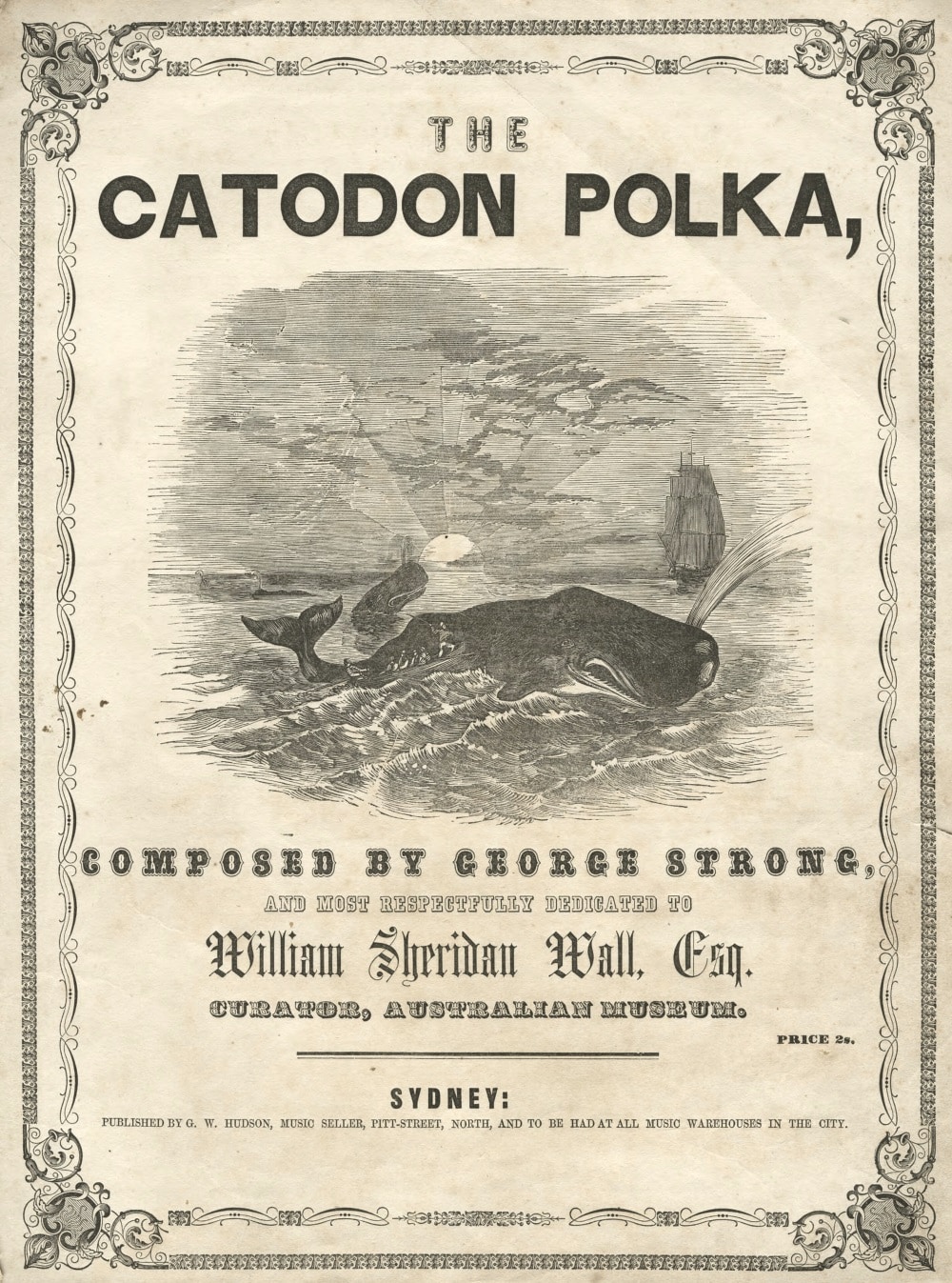
14 January 1854, first announcement, and 23 January, first performance, of The catodon polka
[Advertisement], Empire (14 January 1854), 1
http://nla.gov.au/nla.news-article60148276
JUST PUBLISHED, PRICE 2s. THE CATODON POLKA, composed by GEORGE STRONG, author of the "Escort Polka," and dedicated to William Sheridan Wall, Esq., Curator Australian Museum. Sydney: Published by G. W. Hudson, Music Seller, Pitt-street North, and to be had at all Music Warehouses in the City.
ASSOCIATIONS: George Hudson (music publisher, orchestral player)
"ROYAL VICTORIA THEATRE", The Sydney Morning Herald (21 January 1854), 4
http://nla.gov.au/nla.news-article12951621
MONDAY, JANUARY 23. Greatest Novelty! this Season, and for this night only.
For the Benefit of Mr. JOHN GIBBS, Leader of the Orchestra . . .
In the course of the evening the band, which will be considerably augmented for this occasion, will perform Bellini's celebrated Overture to Norma,
The Catodon Polka, The Topsy Quadrille, &c., &c., . . .
"DONATIONS TO THE AUSTRALIAN MUSEUM DURING THE MONTH OF JANUARY, 1854", The Sydney Morning Herald (10 February 1854), 4
http://nla.gov.au/nla.news-article12953294
. . . Hermit crabs, and specimens of phos, triton, murex, &c., &c., from Middle Harbour. Presented by Mr. George Strong . . .
"DONATIONS TO THE AUSTRALIAN MUSEUM", The Sydney Morning Herald (3 July 1854), 4
http://nla.gov.au/nla.news-article12956780
. . . Skull of an Aboriginal (male), Sydney tribe, from Middle Harbour, by Mr. George Strong . . .
[Advertisement], Empire (26 August 1854), 1
http://nla.gov.au/nla.news-article60196234
ROYAL VICTORIA THEATRE. Andrew Torning, Sole Lessee and Manager . . . feels great pleasure in announcing . . . that the above popular place of amusement . . . will open for dramatic and operatic performances . . . on MONDAY, August 28, with the following company: - Mr. Frank Howson, Operatic Manager; Mr. Lavenu, Musical Director; Mr. John Gibbs, Leader of the Orchestra . . . Messrs. Strong and Mathews, Mesdames Laurence, Brown, and Gilbody, Costumers . . . ORCHESTRA. Messrs. Lavenu, John Gibbs, C. Riffel, G. Strong, J. Guerin, David, R. Vaughan, M. Vaughan, Wright, Wheeler, Turner, Seymour, McLauglin, Bind, Theobald, Earle and Master Hudson . . .
ASSOCIATIONS: Andrew Torning (actor, manager); Frank Howson (vocalist, manager); Lewis Lavenu (musical director); James Guerin; Robert Vaughan; Robert Theodbald; John Turner; George Hudson junior
30 January 1855, death of George Strong senior
"FUNERAL", The Sydney Morning Herald (31 January 1855), 8
http://nla.gov.au/nla.news-article12965027
The Friends of the deceased Mr. George Strong, tailor, are requested to attend his funeral, to move from his late residence, Liverpool-street, near Pitt-street, THIS (Wednesday) AFTERNOON, at a quarter to three o'clock. JAMES CURTIS, undertaker. Hunter-street, January 31.
"DIED", Empire (1 February 1855), 4
http://nla.gov.au/nla.news-article60203544
At his late residence, Liverpool-street, on Tuesday the 30th of January, Mr. George Strong, aged 55.
[Advertisements], Empire (14 December 1855), 1
http://nla.gov.au/nla.news-article60171111
PRINCE OF WALES THEATRE. - FRIDAY, December 14. - BENEFIT OF THE MEMBERS OF THE ORCHESTRA. First time of the New Drama, entitled THE MISER OF SHORE DITCH. Solo Violin, Mr. GEORGE STRONG. Song, THE PEACE OF THE VALLEY, Mr. F. HOWSON. Cornet Obligato, Mr. WHEELER. To conclude with the immensely successful Drama, entitled HELPING HANDS.
ASSOCIATIONS: Stephen Wheeler (cornet player)
"PRINCE OF WALES THEATRE", The Sydney Morning Herald (14 December 1855), 8
http://nla.gov.au/nla.news-article12977655
The performances at the Prince of Wales Theatre this evening, are for the benefit of the members of the orchestra. The Miser of Shoreditch, and Helping Hands, are the pieces named. At the conclusion of the first part, a violin solo, by Mr. George Strong, is announced. Mr. Strong is a native of the colony, and has for some time led the orchestra at this theatre in a highly creditable manner; he is an instrumental performer of no mean capacity, and will, no doubt, sustain the reputation he gained by his previous solo performances a few years ago. In addition to this, Mr. Wheeler plays a solo on the cornet-à-piston.
NOTE: Strong was clearly not a "native of the colony", but he was substantially raised and trained musically in NSW
"DEATHS", The Sydney Morning Herald (24 November 1857), 1
http://nla.gov.au/nla.news-article13003394
On the 3rd instant, at the residence of his uncle, Mr. Commissioner Forster, Tambaroora, James Francis Strong, aged 18, fourth son of the late Mr. George Strong, of Sydney.
[Advertisement], The Sydney Morning Herald (9 June 1858), 1
http://nla.gov.au/nla.news-article13013726
MR. G. STRONG'S Quadrille Assembly, THIS EVENING, June 9th, next to the Old Commodore Hotel, Blue's Point, North Shore. Tickets, to admit a lady and gentleman, 2s 6d. each, to be had at the door.
[Advertisement], The Sydney Morning Herald ((6 November 1858), 1
http://nla.gov.au/nla.news-article13019276
A GRAND SOIREE, at the School of Arts, on WEDNESDAY next, 10th November. Selections of vocal music, under the direction of Mr. Charles Chizlett, with organ accompaniment by Mr. C. S. Packer . . . A violin solo, by Mr. G. Strong . . .
ASSOCIATIONS: Charles Chizlett (conductor); Charles Sandys Packer (organist)
"ALLIANCE BAND OF HOPE. ANNUAL FESTIVAL", The Band of Hope Journal and Australian Home Companion (20 November 1858), 383
http://nla.gov.au/nla.news-article72485524
THE third annual festival of this society was held at the School of Arts on the evenings of the 10th, 11th, and 12th instant . . . Mr. C. Packer played a number of popular melodies on the organ, and Mr. G. Strong, a solo on the violin. The greatest enthusiasm prevailed during the evening, and all departed highly pleased with the amusements.
[Advertising], The Sydney Morning Herald (5 May 1859), 1
http://nla.gov.au/nla.news-article13024504
G. STRONG'S Quadrille Party, THIS EVENING, Figtree Hotel, North Shore.
[Advertisement], The Sydney Morning Herald (3 August 1859), 1
http://nla.gov.au/nla.news-article13028704
G. STRONG, Printer, &c. St Leonard's, near Blue's Inn, North Shore.
"DONATIONS TO THE AUSTRALIAN MUSEUM DURING FEBRUARY", The Sydney Morning Herald (6 March 1860), 4
http://nla.gov.au/nla.news-article13037429
. . . A relic from the fire at North Shore. By Mr. George Strong . . .
"INSOLVENT COURT. - TUESDAY", Empire (3 April 1861), 8
http://nla.gov.au/nla.news-article60494483
George Strong, of St. Leonard's, North Shore, musician. Liabilities, £132 2s. Assets - value of real property, £100; of personal property, £40; total, £200. Surplus, £67 8s. Mr. Mackenzie, official assignee.
"IN INSOLVENCY", New South Wales Government Gazette (9 April 1861), 804
http://nla.gov.au/nla.news-article230061889
"WATER POLICE COURT. - WEDNESDAY. CRUELTY TO ANIMALS", Empire (6 June 1861), 5
http://nla.gov.au/nla.news-article60488767
[Advertisement], The Sydney Morning Herald (24 June 1861), 1
http://nla.gov.au/nla.news-article13062627
MR. G. STRONG, late of Winterbottom's Band, Quadrille Violinist. Address Mr. F. Cunninghame, printer, Pitt-street.
ASSOCIATIONS: John Winterbottom (band leader, bassoonist); Francis Cunninghame (printer)
"DEATHS", The Sydney Morning Herald (29 June 1865), 1
http://nla.gov.au/nla.news-article31124580
On the 28th instant, at the residence of his parents, Miller-street, St. Leonards, North Shore, George John, eldest son of Elizabeth and George Strong, aged 16 years, deeply regretted by all who knew him.
"ST. LEONARDS VOLUNTEER RIFLES", The Sydney Morning Herald (6 October 1866), 6
http://nla.gov.au/nla.news-article13141270
A complimentary ball to Captain Garrett, Volunteer Rifles . . . was given in the School of Arts, North Shore, on Thursday night last . . . Dancing commenced shortly after 9, to the music of an excellent band under Mr. Strong . . .
"LIST OF DONATIONS TO THE AUSTRALIAN MUSEUM DURING MAY AND JUNE, 1867", The Sydney Morning Herald (27 July 1867), 6
http://nla.gov.au/nla.news-article13154177
. . . A sea snake (Pelamis bicolor). By Mr. George Strong . . .
[Advertisement], The Sydney Morning Herald (1 January 1868), 8
http://nla.gov.au/nla.news-article28608627
PEARL BAY, MIDDLE HARBOUR. - New Year's Day.- Mr. G. STRONG'S Quadrille Band of five Performers will arrive by first steamer. No charge for dancing.
"DEATH", Evening News (1 December 1875), 4
http://nla.gov.au/nla.news-article130494164
STRONG. - On the 30th November, at Mitchell-street, North Shore, Elizabeth, the dearly beloved wife of Mr. George Strong, in the 47th year of her age.
[Advertisement], The Sydney Morning Herald (8 January 1877), 8
http://nla.gov.au/nla.news-article28398358
MR. G. STRONG, Violinist, &c, Mitchell-street, Blue's Point, North Shore.
"Deaths", The Sydney Morning Herald (30 October 1878), 1
http://nla.gov.au/nla.news-article13411576
STRONG. - October 29, at his residence, Mitchell-street, St. Leonards, Mr. George Strong, brother of Captain H. W. Strong, aged 54 years.
"ECCLESIASTICAL JURISDICTION", New South Wales Government Gazette (16 April 1879), 1731
http://nla.gov.au/nla.news-article223118006
ECCLESIASTICAL JURISDICTION. IN the estate of George Strong, late of St. Leonards, near Sydney, in the Colony of New South Wales, compositor, deceased. NOTICE is hereby given, that at the expiration of fourteen days from the publication hereof, application will be made to this Honorable Court, in its Ecclesiastical Jurisdiction, that letters of administration of the estate and effects of the above-named deceased may be granted to Elizabeth Catherine Strong, of St. Leonards aforesaid, spinster, the eldest daughter, and one of the next of kin of the said deceased. - Dated this 11th day of April, a.d. 1879, MCCARTHY, ROBERTSON, & FISHER, Proctors for the said Elizabeth Strong, Pitt-street North, Sydney.
[Advertisement], The Sydney Morning Herald (28 June 1879), 13
http://nla.gov.au/nla.news-article28390838
BLUE'S POINT, overlooking BERRY'S BAY, NORTH SHORE. By order of the Administratrix In the Estate of the late Mr. George Strong. Preliminary Notice. HARDIE and GORMAN have received instructions from the Administratrix to sell by public auction, at their PROPERTY SALE ROOMS, 175, Pitt-street, at 11.30 o'clock, on WEDNESDAY, 9th JULY, at 11.30 o'clock, All that BLOCK of LAND fronting MITCHELL-STREET, a short distance off BLUE'S POINT ROAD, having a frontage of 30 feet by a depth of 100 feet, upon which is erected GERANIUM COTTAGE, built of weather-board, and containing verandah, 4 rooms, and kitchen, and is now let at 10s per week. *.* This is a snug little property, commanding pretty views of COCKATOO ISLAND, PARRAMATTA RIVER, and BALMAIN. Further particulars in a few days. DAY OF SALE, WEDNESDAY, 9th JULY.
"DEATHS", The Sydney Morning Herald (19 November 1928), 10
http://nla.gov.au/nla.news-article16510380
STRONG. - November 17, 1928, at her residence, 27 Victoria-street, North Sydney, Elizabeth Catherine Strong, in her 80th year.
George Strong, composer, musical works
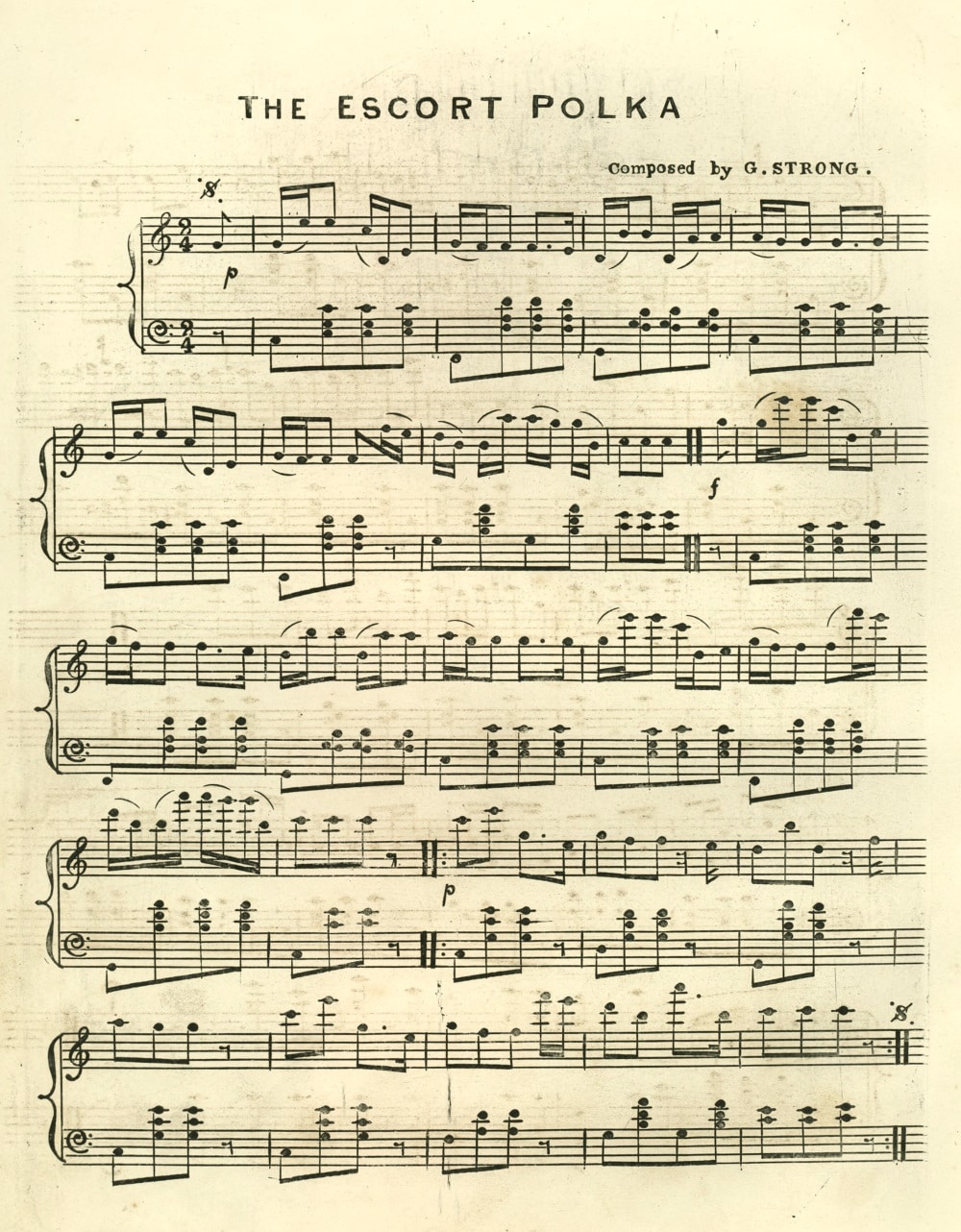
The escort polka (The gold escort polka) (1852)
https://trove.nla.gov.au/search?l-publictag=The+escort+polka+(Strong) (TROVE tagged by Australharmony)
The escort polka, composed by G. Strong
(Sydney: Published by G. Hudson, [1852/53])
Copy at National Library of Australia
https://trove.nla.gov.au/version/22568969
https://nla.gov.au/nla.obj-165700226 (DIGITISED)
See above for Documentation

The catodon polka (1854)
The catodon polka, composed by George Strong, and respectfully dedicated to William Sheridan Wall, esq., curator, Australian Museum
(Sydney: Published by G. W. Hudson, [1854])
Copy at the National Library of Australia
https://trove.nla.gov.au/work/30449038
http://nla.gov.au/nla.mus-an11032321 (DIGITISED)
See above for Documentation
Graeme Skinner, "The catodon polka", Australian Museum
https://australianmuseum.net.au/the-catadon-polka
Synthesised sound file, Australharmony 2018
On the Australian Musuem's catodon:
Apart from what little can be reconstructed of his professional musical and family histories, the one other interesting thing we know about George Strong is that he was a keen amateur naturalist. George had evidently grown up with the Australian Museum. As a young adult during 1840s he watched as the core of today's sandstone building was erected on the corner of William and College Streets, and, once it was opened to the public, he became one of the hundreds of colonists who helped build its collections.
From January 1854 onward, The Sydney Morning Herald published monthly lists of specimens of flora, fauna, minerals, and manmade curiosities donated to the Museum by collectors and fossickers, mostly members of the general public. Early donors included the artist John Skinner Prout, Sydney University's first chancellor Charles Nicholson, Roman Catholic bishop Charles Davis, and numerous enterprising children, including the museum director's own son and daughter, Master William and Miss Martha Wall. Strong appears in the very first list, "DONATIONS TO THE AUSTRALIAN MUSEUM DURING THE MONTH OF JANUARY, 1854":
Hermit crabs, and specimens of phos, triton, murex, &c., &c., from Middle Harbour. Presented by Mr. George Strong.
In June, Strong followed this with what would today be the unacceptable gift of the:
skull of an Aboriginal (male), Sydney tribe, from Middle Harbour.
Strong continued to look out specimens for the Museum, and made at least two more recorded donations. After a large fire broke out on Blues Point Road, on the night of 26 February 1860, he donated "A relic from the fire at North Shore". And several years later, in the list of donations for May and June 1867, we find:
A sea snake (Pelamis bicolor). By Mr. George Strong.
Not surprisingly, then, Strong was among the many Sydneysiders fascinated by news of what was not only an extraordinary new specimen at the museum, but also a new species. The museum first reported on the acquisition in this pamphlet published in April 1851.
History and description of the skeleton of a new sperm whale, lately set up in the Australian Museum by William Sheridan Wall . . . (Sydney: W. R. Piddington, 1851)
https://www.biodiversitylibrary.org/page/7122040#page/7/mode/1up (DIGITISED)
In the pamphlet, Wall recounted how the skeleton had been found, how he had acquired it, and how the exhibit was then set up at the museum:
It was announced in the Sydney Herald of the 5th December, 1849, that the carcass of a sperm whale had been found at sea and had been towed by the schooner Thistle into the harbour of Port Jackson. As the curator of the Australian Museum, I considered that the skeleton would form a valuable addition to our collection; so with the permission of the Museum Committee, I lost no time in proceeding to Neutral Bay, where the schooner then was at anchor, having a male whale alongside.
Mr. Williamson, the master of the vessel, as soon as he was made acquainted with the object of my visit offered me most liberally the entire skeleton, with the exception of the under jaw, which he was desirous of retaining for the sake of the teeth. On my representing, however, to him the advantage of our possessing a complete skeleton, he eventually consented to my taking away the whole of the bones.
The blubber portions of the carcass had, on account of the oil been removed previously to my arrival on the spot, but as soon as I was in possession of all that remained I proceeded to adopt proper measures for cleaning the bones. After considerable difficulty in finding persons willing to encounter so unpleasant, and as they imagined so unhealthy a task, I at last succeeded in engaging four Portuguese sailors, who had been some years employed in the whale fishery.
It was, however, then discovered that a portion of the tail, containing ten of the caudal vertebrae, and also that a fin, were deficient. The tail had been sent to Sydney with the blubber; but as I soon found it on Hughes' Wharf, in Sussex-street, I then by permission of Colonel Baddaley, of the Royal Engineers, carried the whole of the bones in my possession to Pinchgut Island, where, under a course of lime and other preparations, at the end of two months they were thoroughly bleached and freed from oil and all offensive odour.
As to the lost fin, every hope of recovering it had been abandoned, when I was informed by two boys that a strange fish was lying on a rock near the bath, in Woolloomooloo Bay. This, fortunately, turned out to be the part missing, which, by the way, was by far the most interesting of the two fins, as it was the right one, the bones of which are considerably larger than those of the left, and also more perfect . . .
The skeleton . . . has been erected on strong iron supports, and the cartilaginous substance into which the hones of Cetacea so readily pass, and which occurs so plentifully between the vertebrae, has been carefully replaced by gutta percha substitutes, after drawings taken carefully by me on the spot where the carcass was cut up. The whole length of skeleton as set up is thirty three feet six inches . . .
Sheridan Wall dubbed the whale Catodon Australis, and as he noted already:
The skeleton set up appears to excite considerable interest among the curious of Sydney.
So much so that, by 1853, the museum's very limited opening hours became a subject of hot dispute from visitors wanting to view the whale. Unscrupulous Sydney cabmen were reportedly making a habit of taking:
unsuspecting innocent strangers up to the Museum, where they expected to be regaled with a sight of the 'vonderful Bengal tiger . . . not to speak of the skeleton of that 'ere antedeluvian whale wot 'vos 'arpooned . . . and the numerous other objects of interest which we were led to believe could be seen at the Sydney Museum.
only to find the premises firmly padlocked, and so have to pay the cabbie another fare back to the town.
But perhaps the most original and unexpected of all responses came from our musician, George Strong, who, probably sometime during 1853, composed a polka in the catodon's honour, and "respectfully dedicated" the music on publication in mid-January 1854 to "William Sheridan Wall, Esq., curator Australian Museum".
A week so after the sheet music (for piano) was published, there was also a performance of the polka by Strong's own orchestra, at the Royal Victoria Theatre, took place on 23 January 1854.
Strong's polka itself - a fairly unassuming little piece - runs to just a single page of music. However, the publisher, George Hudson, went to considerable trouble with the cover, which is decorated with a rather impressive engraving of the monster returned to life. Probably as many people bought the polka for the illustration (unsigned, but perhaps by Walter Mason) as for the music itself.
Sadly, it turned out to be Hudson's last publication. Six months later, on 27 July, "Mr. George Hudson, Music Seller and Publisher" died "after a short but severe illness, much regretted by a numerous circle of friends, leaving a widow and two children to lament their loss." That widow later took as her second husband William Sheridan Wall, who had apparently been a close friend or possibly a relative of George Hudson.
George Strong, violinist, and the Cuckoo solo
During the 1840s and 1850s, George Strong is only occasionally reported as having emerged from the ranks of Sydney's theatrical orchestras and concert ensembles to appear as violin soloist.
He had almost certainly been protege, and probably also a pupil, of the leader of Sydney's theatrical band, John Gibbs. And it is probably significant that he was first billed as playing an unidentified violin solo between the pieces at John and Eliza Gibbs's benefit on 28 May 1847 (the main feature of which was a performance of Henry Bishop's version of Mozart's The marriage of Figaro).
A later solo billing had him playing an unidentified Air and variations programmed likewise between the pieces at a benefit for the members of the orchestra on 13 November 1851. And for Howard's Serenaders, at the Royal Hotel on 20 September 1852, he gave a violin solo introducing airs from the popular and traditional songs By the sad sea waves, Auld Robin Gray, and Savourneen Deelish.
However, the only surely identifiable musical work he is reported to have played was the so-called Cuckoo solo. This much admired party piece was especially favoured by younger violinists throughout the 19th-century both in homeland Britain and in its current and former colonies. At his final farewell performance in Melbourne on 9 December 1881, George Coppin returned to the beginning of his long stage career by telling the audience:
The first printed record I have of my public appearance is the bill of a concert given at Peterborough, under the patronage of Viscount Lord Milton, on the 14th November, 1826, in which I am announced amongst the violin players. I was then 7 years old, and used to be placed upon a table to play the Cuckoo Solo between the pieces. I remember having coppers and small pieces of silver thrown upon the stage to me . . .
"MR. COPPIN'S FAREWELL", The Age (10 December 1881), 6
http://nla.gov.au/nla.news-article201992123
The same piece was first referred to in a surviving Australian concert program on 11 August 1846, when it was one of several "themes" that John Philip Deane introduced into set to variations of Rousseau's dream, a juvenile string trio composed for and performed by his three youngest sons, Charles Muzio, Alfred, and Henry (the other two introduced tunes belonged to a recently popular American minstrel song The hen and chickens and to Tom Moore's Believe me if all those endearing young charms).
By then, the piece itself had no doubt been previously performed in the Australian colonies on many unadvertised and unreported occasions. However, the first actual recorded performance of it was one advertised to be given by John Gibbs, during a concert for Howard's Serenaders, on 13 September 1852.
Perhaps because it was well received when Gibbs had played it, the Serenaders programmed it again for the last night of their season, two weeks later, on 27 September, when Gibbs, otherwise busy in the pit at the Royal Victoria, sent along George Strong to play it in his stead. The Gibbs again asked Strong to play it at the theatre, for Eliza Gibbs's benefit, on 19 May 1853, and he repeated the performance the following night.
Five months later, at the theatre in provincial Bathurst, on 10 October 1853, the Cuckoo solo was billed to be given by a young local violinist, the 19-year-old George Chittenden junior.
It was also a repertoire favourite of several other young colonial violinists, notably the teenager John Thomson Hall who played it at the theatre Launceston on 10 June 1857, and, on 17 July 1862, the 7-year-old "infant Paganini" of Melbourne, George Weston
When another infant prodigy, John Frederick Molteno, played it in Sydney on 1 February 1866, the piece was more fully billed as "The Celebrated Cuckoo Solo . . . Vivaldi".
Antonio Vivaldi had been generally named as composer of the Cuckoo solo since the first decades of the century, and probably much earlier. Two printed editions now in the British Library, and attributing him with its authorship, were issued in London in the early 1820s under the imprints of William Sibley and R. W. Keith. An early English manuscript reported source was a copy of "The celebrated Cuckoo Solo by Vivaldi" made by William Irwin, of Keswick, in the 1830s, to which he added his own "variation"
The celebrated Cuckoo Solo by Vivaldi with a variation Solo by Wm. Irwin, Keswick; appears in Anne Geddes Gilchrist's inventory of the William Irwin manuscript tune book, 1838 ("William Irwin's Book Jan. 2 1838"); the original MS is now lost, and this item was not transcribed by Gilchrist.
http://folkopedia.efdss.org/wiki/IRWIN,William
Over a century earlier, an authentic violin concerto in A major by Vivaldi, called "The cuckow", appeared in several English print editions. And recalling Vivaldi's popularity around the time of his own adolescence (c.1740), Charles Burney later wrote:
His Cuckoo Concerto, during my youth, was the wonder and delight of all frequenters of country concerts; and [Thomas] Woodcock, one of the Hereford Waits, was sent far and hear to perform it.
A general history of music . . . volume the third (London: For the auhtor, 1789), 561
https://books.google.com.au/books?id=EEFDAAAAcAAJ&pg=PA561
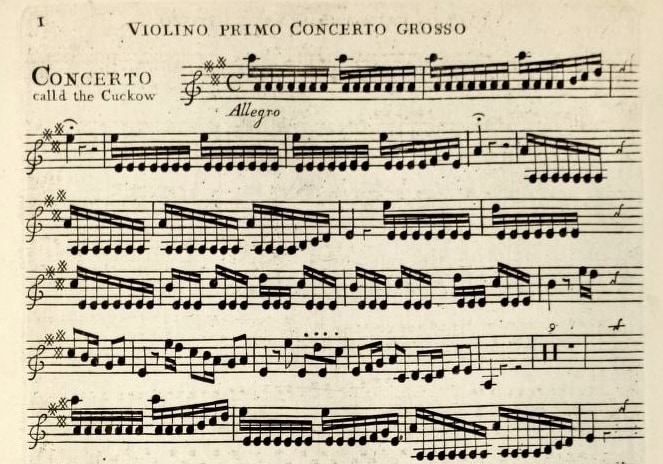
Two celebrated concertos: the one commonly call'd The cuckow and the other Extravaganza compos'd by Sigr. Antonia Vivaldi (London: John Walsh, [? c.1730]) (University of Western Ontario)
https://archive.org/stream/twocelebratedcon00viva#page/n3/mode/2up
Signally, the first movement of Vivaldi's "Cuckow" concerto shares its key, metre, and a few salient characteristics with the later Cuckoo solo. And while there's no question of the Cuckoo solo being derived directly from Vivaldi's movement, it is clearly intended to be a much simplified, generic evocation of the Italian master's style.
The Cuckoo Solo in TROVE:
https://trove.nla.gov.au/search?l-publictag=Cuckoo+solo (TROVE tagged by Australharmony)
Sources of the music of The Cuckoo Solo:
The cuckoo solo, in the James Nuttall MS, c.1830 (Rossendale Museum, East Lancashire, England); folk tune finder
http://www.folktunefinder.com/tunes/29887 (EDITION)
http://www.village-music-project.org.uk/wp-content/uploads/2016/03/Nuttall.pdf (EDITION)
On the source, see:
http://www.village-music-project.org.uk/?page_id=684 (INFO)
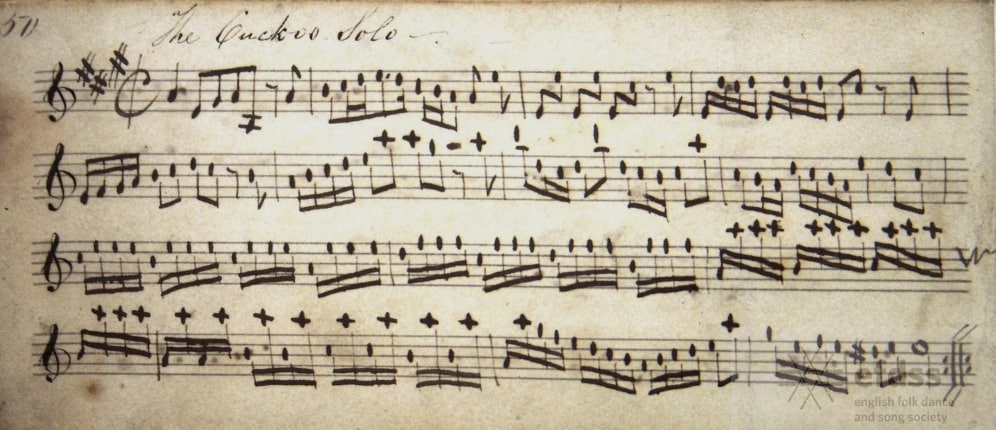
The cuckoo solo, in the John Moore MS book no. 2, c.1840, Shropshire, England (English Folk Dance and Song Society; Vaughan Williams Memorial Library)
https://www.vwml.org/browse/browse-collections-dance-tune-books/browse-moore2#recordnumber=41 (DIGITISED)
http://www.folktunefinder.com/tunes/150596
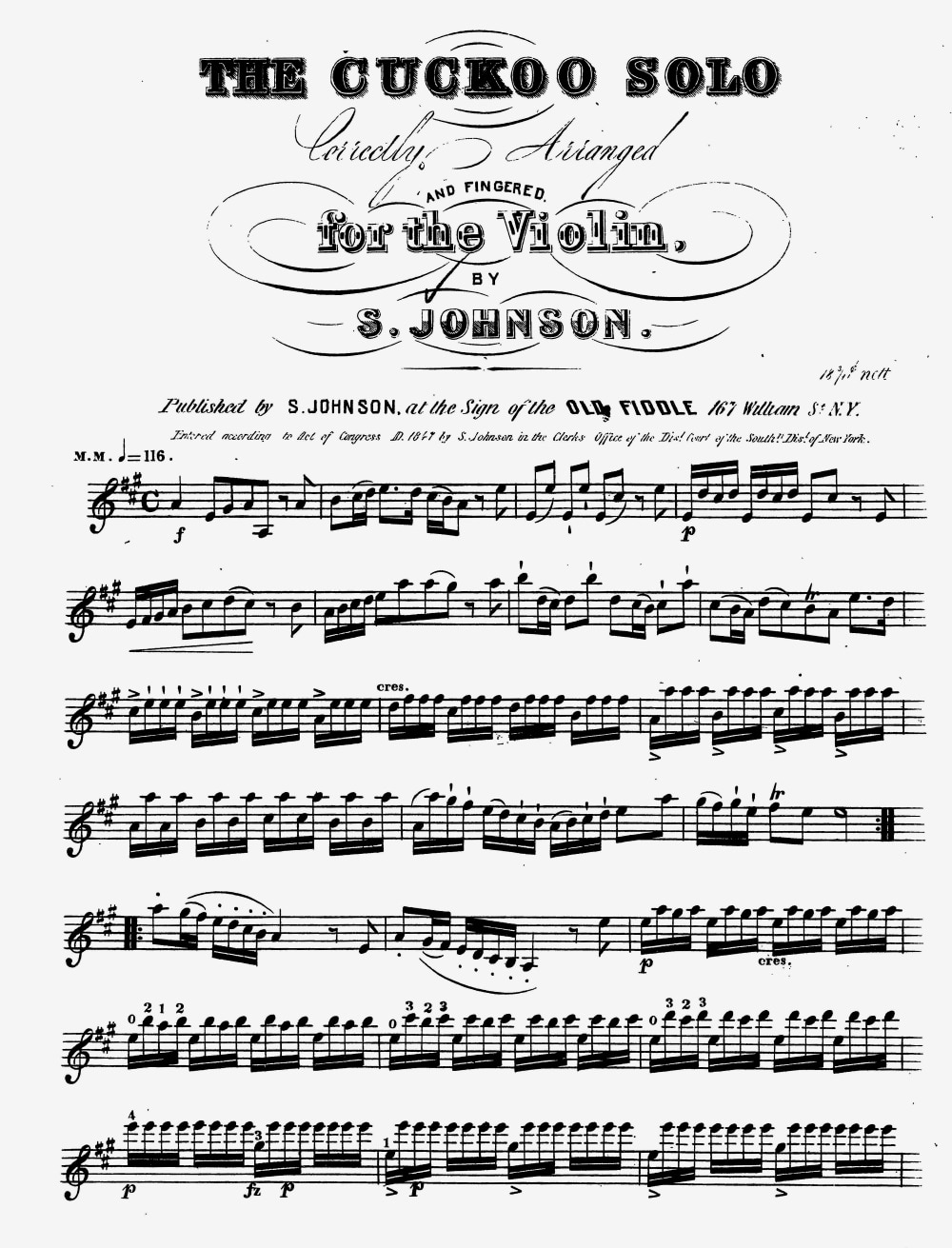
The cuckoo solo, correctly arranged and fingered for the violin, by S. Johnson (New York: S. Johnson, at the sign of the Old Fiddle, 1847)
Copy at the Library of Congress (page 1 of 2 pictured above)
https://www.loc.gov/item/sm1847.070560 (DIGITISED)
And reports of two English performances:
J. L. Levison, "Remarks on musical precocity", The Analyst: a quarterly journal of science, literature . . . 7 (1837), 57
https://books.google.com.au/books?id=XuQRAAAAYAAJ&pg=PA57
[MASTER WILLIAM MANTON, Commonly Called "The Infant Paganini." This child is not quite six years old . . .] . . . I attended a "Musical Melange" and was delighted with the little premature performer. He played the Cuckoo solo, and also St. Patrick's Day in the Morning, on one string (à la Paganini) . . .
"JUVENILE PERFORMERS", Blackwood's Lady's Magazine (September 1846), 142
https://books.google.com.au/books?id=dD4FAAAAQAAJ&pg=RA1-PA142
On Wednesday afternoon three little girls, of the name of Turner, from Bath, we believe, aged severally (according to the programme) eight, six, and four, gave a private performance at the St. James's Theatre, preparatory to their public appearance . . . The youngest displayed very promising talent on the violin (a small one) in the "Cuckoo" solo . . .
Emily Strong and her album
STRONG, Emily (Miss E. STRONG; Mrs. Harold MACLEAN; McLEAN)
Amateur musician, vocalist, ? pianist
Born Hobart Town, VDL (TAS), en route to Sydney, NSW, 12 October 1833; baptised St. James's, Sydney, 22 December 1833; daughter of George and Catherine STRONG, younger sister of George STRONG junior
Married Harold MACLEAN (1829-1889), Mudgee, NSW, 16 May 1856
Died Sofala, NSW, 31 May 1860
https://trove.nla.gov.au/search?l-publictag=Emily+Strong+Maclean+1833-1860 (TROVE tagged by Australharmony)
Documentation (Emily):
"MARRIAGES", The Sydney Morning Herald (31 May 1856), 1
http://nla.gov.au/nla.news-article12981740
At St. Stephen's Church, Louisa Creek, Western Gold Fields, by the Rev. H. A. Palmer, assisted by the Rev. G. Gunther, Harold, third son of J. Legburn Maclean, Esq., formerly Captain H. M. 43rd Regiment Light Infantry, to Emily, eldest daughter of the late George Strong, Esq.
"BIRTHS", The Sydney Morning Herald (13 April 1857), 1
http://nla.gov.au/nla.news-article12994133
On the 31st March, at the Stoney Creek gold-field, the wife of Harold Maclean, Esq., P.M., Gold Commissioner, of a son.
"BIRTHS", The Sydney Morning Herald (4 March 1859), 1
http://nla.gov.au/nla.news-article13013928
On the 25th February, at Sofala, the wife of Harold Maclean, Esq., of a daughter
"BIRTHS . . . DEATHS", The Sydney Morning Herald (13 June 1860), 10
http://nla.gov.au/nla.news-article13041767
BIRTHS . . . MACLEAN - May 17th, at Sofala, the wife of Harold Maclean, Esq., of a son . . . DEATHS . . . McLEAN - May 30th, at Sofala, Emily, wife of Harold McLean, Esq., Gold Commissioner, in her 26th year.
"DEATHS", The Sydney Morning Herald (18 May 1861), 1
http://nla.gov.au/nla.news-article13061363
On the 5th instant, at Sofala, Charles Grant Feilding, the infant son of Harold Maclean, Esq., aged eleven months.
On Emily's husband, see:
"Death of Mr. Harold Maclean", The Sydney Mail and New South Wales Advertiser (9 November 1889), 1031
http://nla.gov.au/nla.news-article162069434
"OBITUARY. MR. HAROLD MACLEAN", Australian Town and Country Journal (16 November 1889), 10
http://nla.gov.au/nla.news-article71125808
Suzanne Edgar, "Maclean, Harold (1828-1889)", Australian dictionary of biography 5 (1974)
http://adb.anu.edu.au/biography/maclean-harold-4122
*
The album
A album of sheet music originally bound for Emily Strong is now at University of Sydney, Rare Books Library, Sydney Conservatorium of Music collection. As of March 2017, this un-numbered volume and its contents do not yet appear in the library's electronic catalogue.
https://library.sydney.edu.au/collections/rare-books

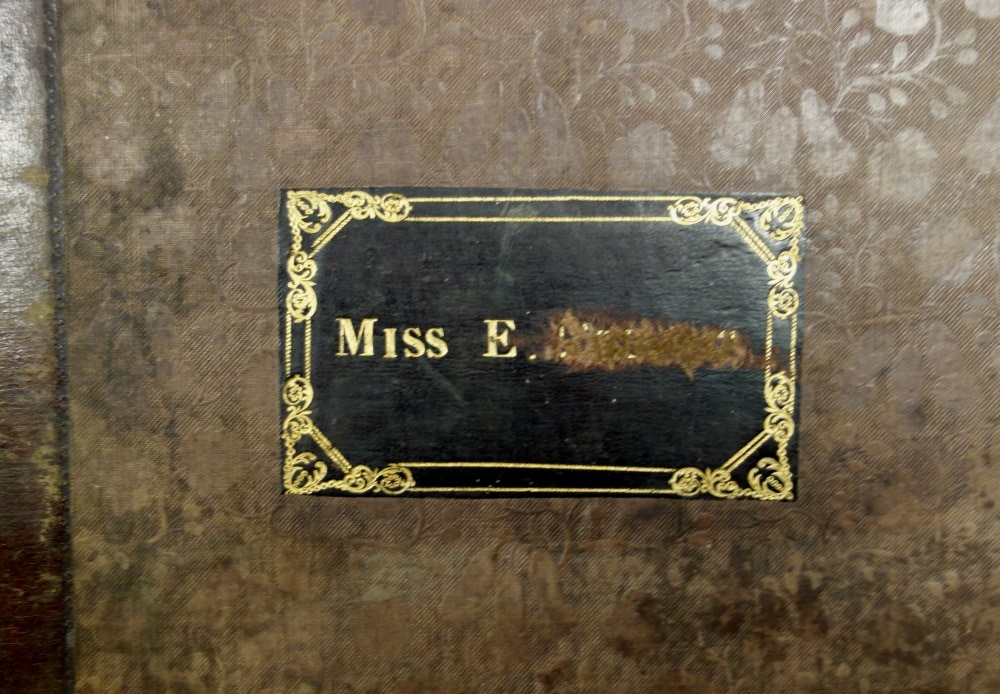
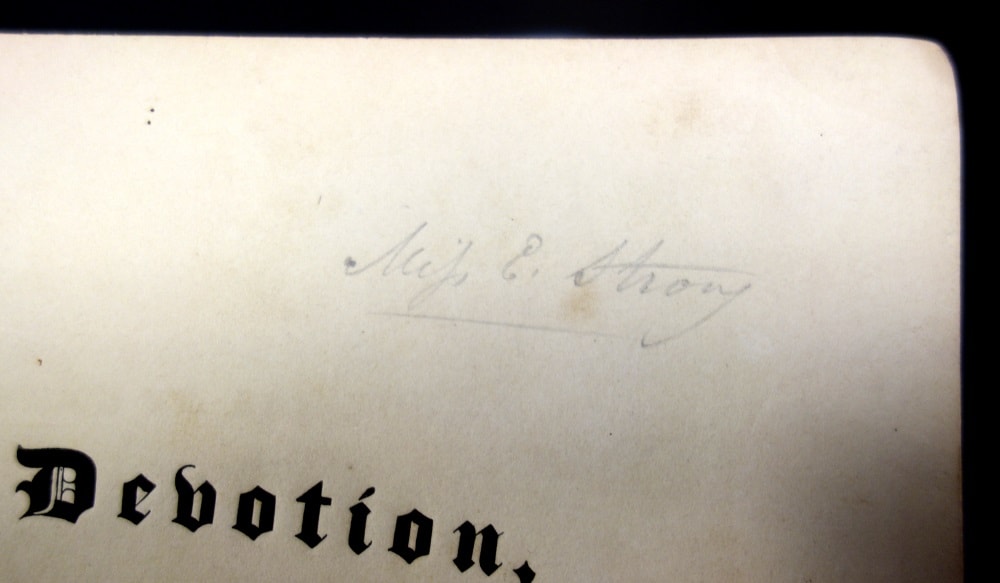
This pencilled inscription is the single sign of ownership on any of the sheet music items in the collection, and was probably written there, on the front item, simply as a guide to the artisan responsible for making the cover label.
It may not even be Emily's handwriting.
Elsewhere, however, as discussed below, there is ample evidence of a single owner making consistent pencilled alterations and additions to the musical texts. Whether that annotator was Emily herself, or a later owner-user, we can probably never know for sure.
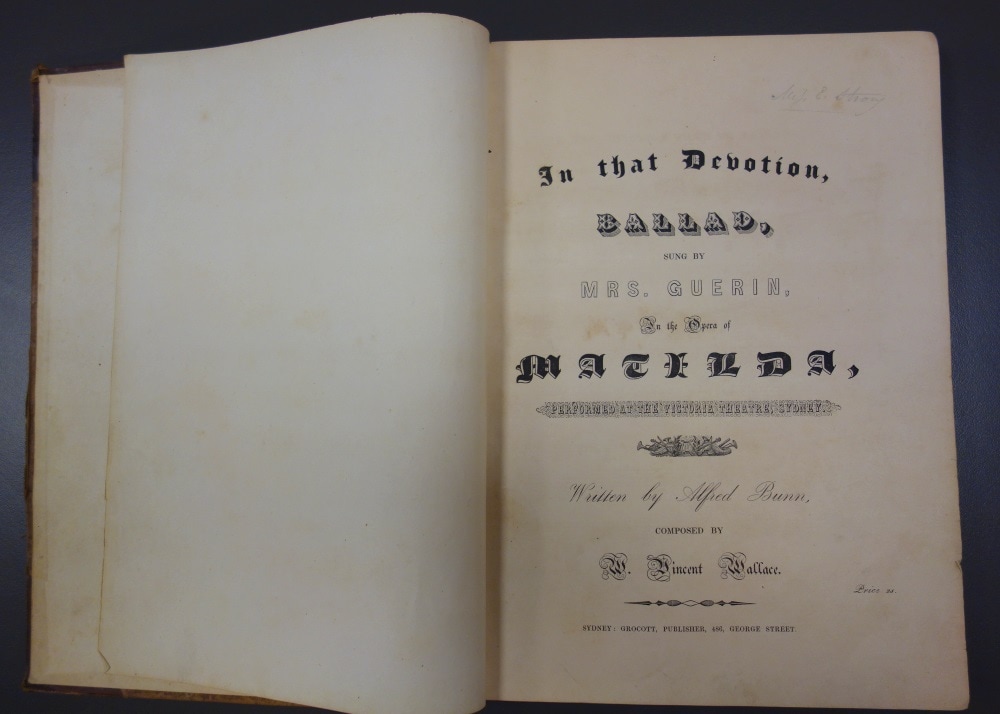
CONTENTS
KEY:
Items published in Sydney
Items by Isaac Nathan published in London and imported
Items published in London and imported
1 In that devotion (Wallace / Grocott / ? 1850)
In that devotion, ballad, sung by Mrs. Guerin in the opera of Matilda, performed at the Victoria Theatre, Sydney, written by Alfred Bunn, composed by W. Vincent Wallace
(Sydney: Grocott, publisher, 486 George Street, n.d. [? 1850])
Titlepage (0), pencil inscription: "Miss E. Strong"; 4 pages music (2-5), page 2 is recto, 3 verso and so on
Another copy at the National Library of Australia
http://nla.gov.au/nla.obj-168408815 (DIGITISED)
WALLACE, William Vincent (music composed)
GUERIN, Theodosia (soprano vocalist)
GROCOTT, James Turner (publisher)
Wallace's Matilda of Hungary was first performed in London in February 1847, and Grocott reproduced several reviews when he first advertised sheet music of three songs from it for sale in Sydney in September 1847. Grocott advertised another a selection of songs from the opera, including "In that devotion", for sale in February 1850. The opera was first staged at the Sydney theatre on 7 March, with Theodosia Guerin in the title role, and the next morning Grocott advertised that he had for sale "all the good songs . . . also, the libretto", having himself printed the later for the run of the production, the subsequent performances of which were on 14 and 21 March, 11 April, 25 July, 8 August, and 7 and 21 November. Mrs. Guerin also sang "In that devotion" at Sara Flowers' concert at the theatre on 27 June, and a print edition appeared as no. 41 in Grocott's catalogue on 31 August, though it remains unclear whether this was this, his own edition, or an import.
[Advertisement], The Sydney Morning Herald (7 September 1847), 1
http://nla.gov.au/nla.news-article12900310
[Advertisement], The Sydney Morning Herald (9 February 1850), 1
http://nla.gov.au/nla.news-article12915595
[Advertisement], The Sydney Morning Herald (7 March 1850), 2
http://nla.gov.au/nla.news-article12916249
[Advertisement], The Sydney Morning Herald (26 June 1850), 3
http://nla.gov.au/nla.news-article12919032
[Advertisement], The Sydney Morning Herald (31 August 1850), 1
http://nla.gov.au/nla.news-article12920685
CATALOGUE OF MUSIC AT GROCOTT'S . . . SONGS [1-111] . . . 41 In that devotion . . .
Grocott's edition of the libretto:
A new grand opera, entitled Matilda of Hungary, in three acts, as performed at the Victoria Theatre, Sydney, the whole of the music composed expressly by W. V. Wallace, the words by Alfred Bunn, esq.
(Sydney: J. T. Grocott, 1850)
37 pages words only; on cover: "The music to be had at Grocott's, 486 George Street."
Copy at the University of Adelaide, Barr Smith Library
https://trove.nla.gov.au/work/33537976/version/41227275%20209260717
2 Overture to Il Tancredi (Rossini / Grocott / ? c1850)
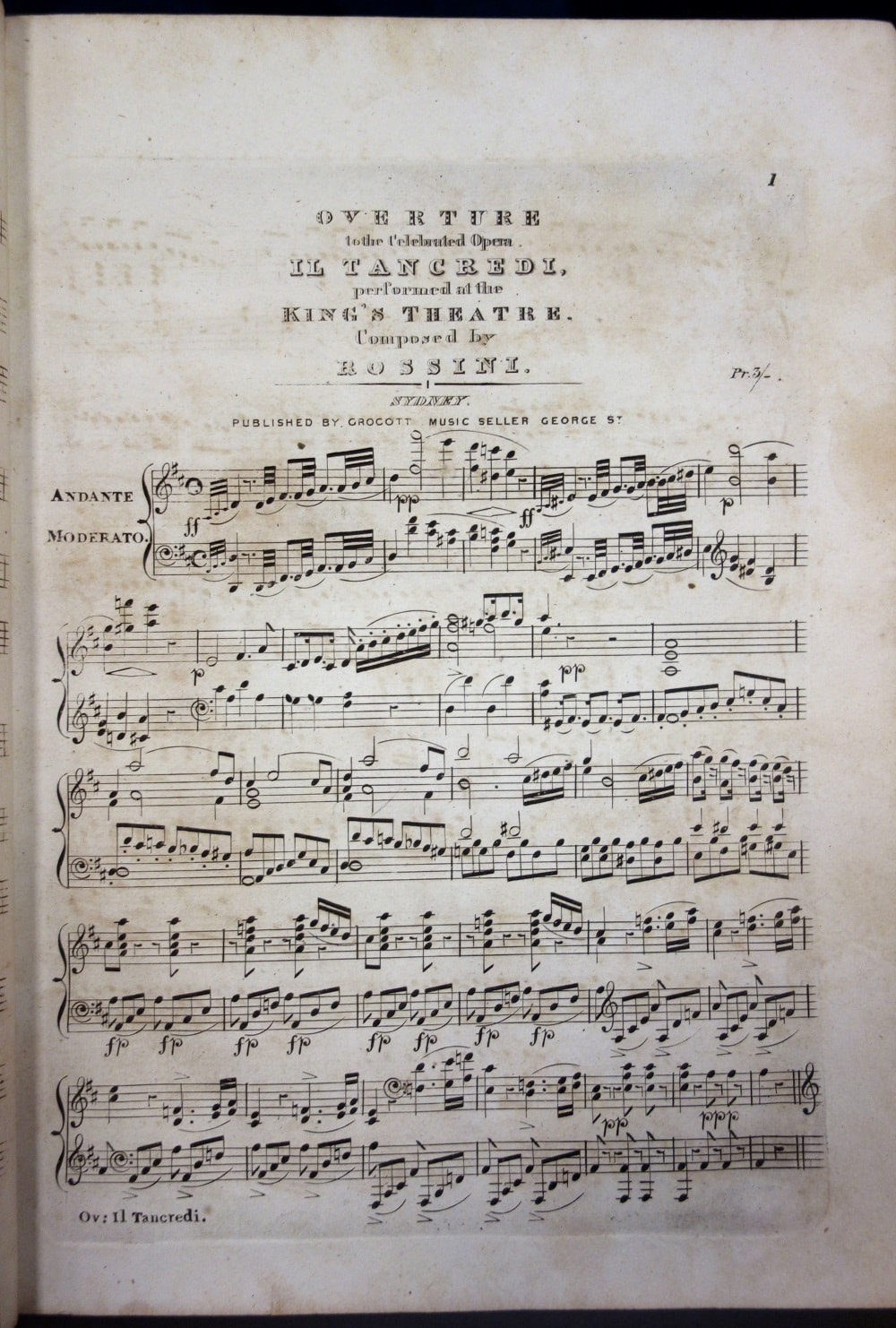
Overture in the celebrated opera Il Tancredi, performed at the King's Theatre, composed by Rossini
(Sydney: Published by Grocott, music seller, George St., n.d. [? c.1850])
No separate title page, 7 pages of music (1-7)
NO OTHER COPY OF THIS EDITION IDENTIFIED (? UNIQUE)
GROCOTT, James Turner (publisher)
http://nla.gov.au/nla.news-article12920685
CATALOGUE OF MUSIC AT GROCOTT'S . . . OVERTURES [197-205] . . . 205 Il Tancredi . . .
3 In happy moments (Wallace / Hudson / ? 1846-47)
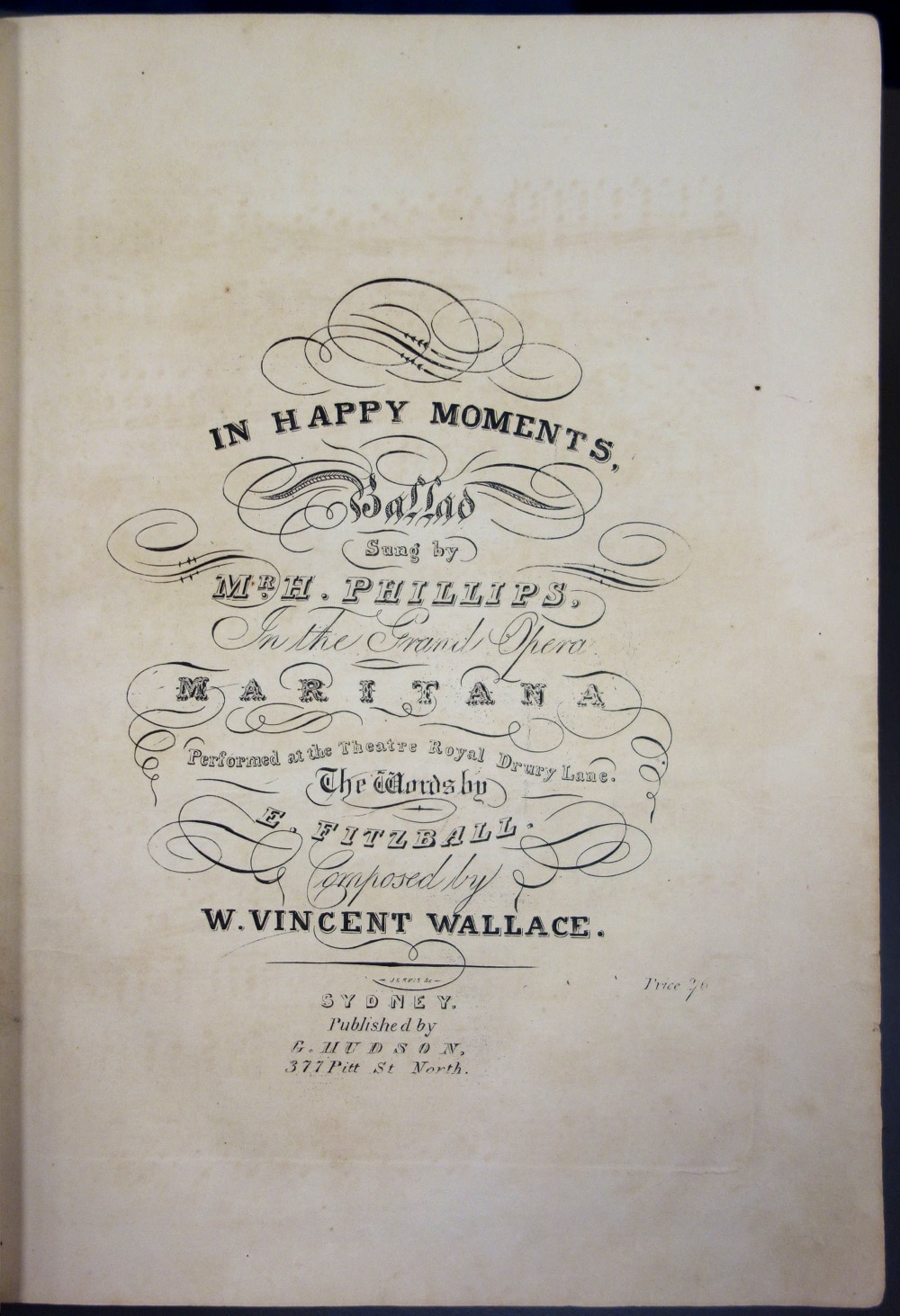
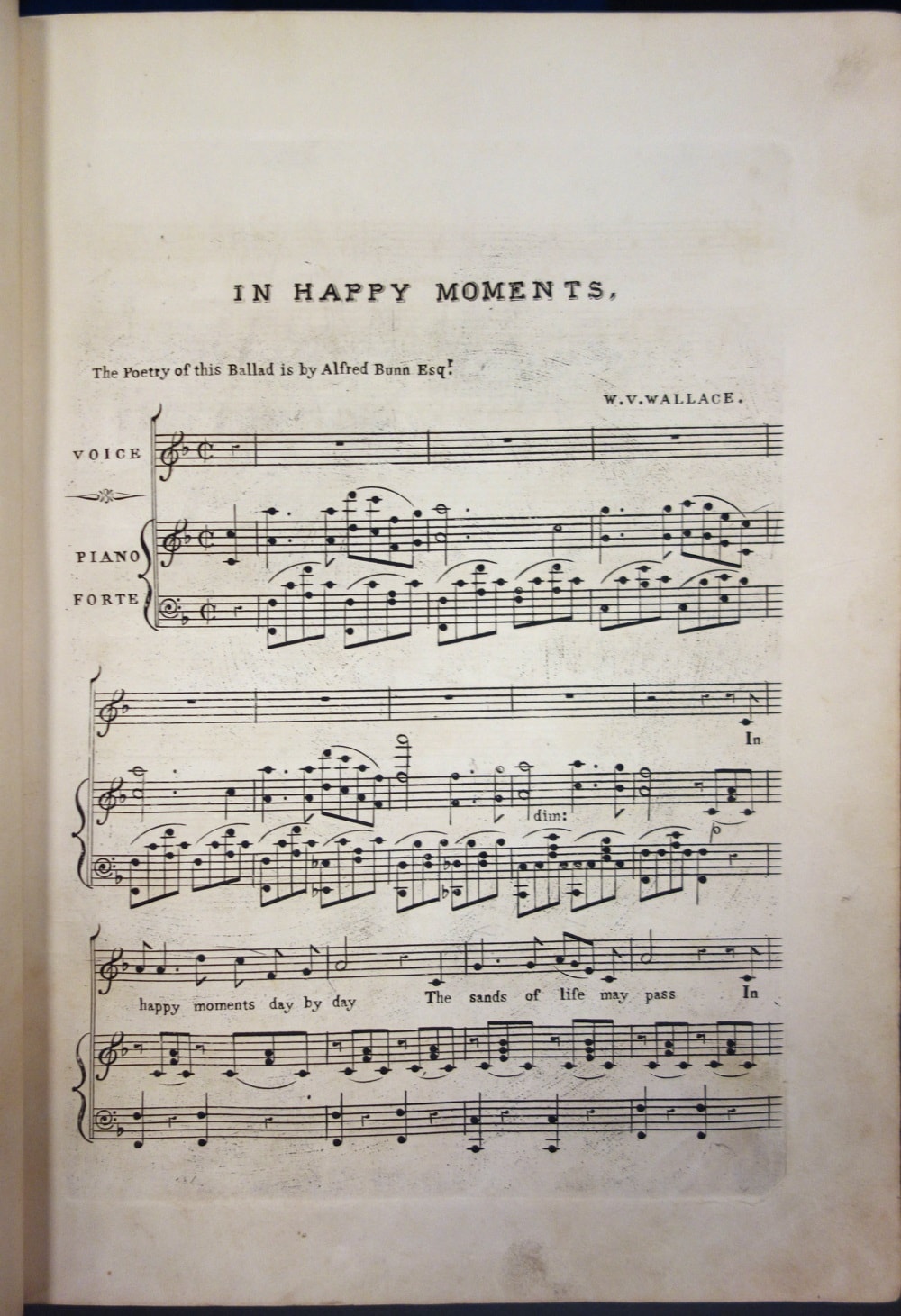
In happy moments, ballad, sung by Mr. H. Phillips, in the grand opera Maritana, performed at the Theatre Royal Drury Lane, the words by E. Fitzball, composed by W. Vincent Wallace
(Sydney: Published by G. Hudson, 377 Pitt St. North, n.d. [? 1846-47])
Titlepage (0), "Jervis Sc", 5 pages music (1-5); original plates plausibly 1846
NO OTHER COPY OF THIS EDITION IDENTIFIED (UNIQUE)
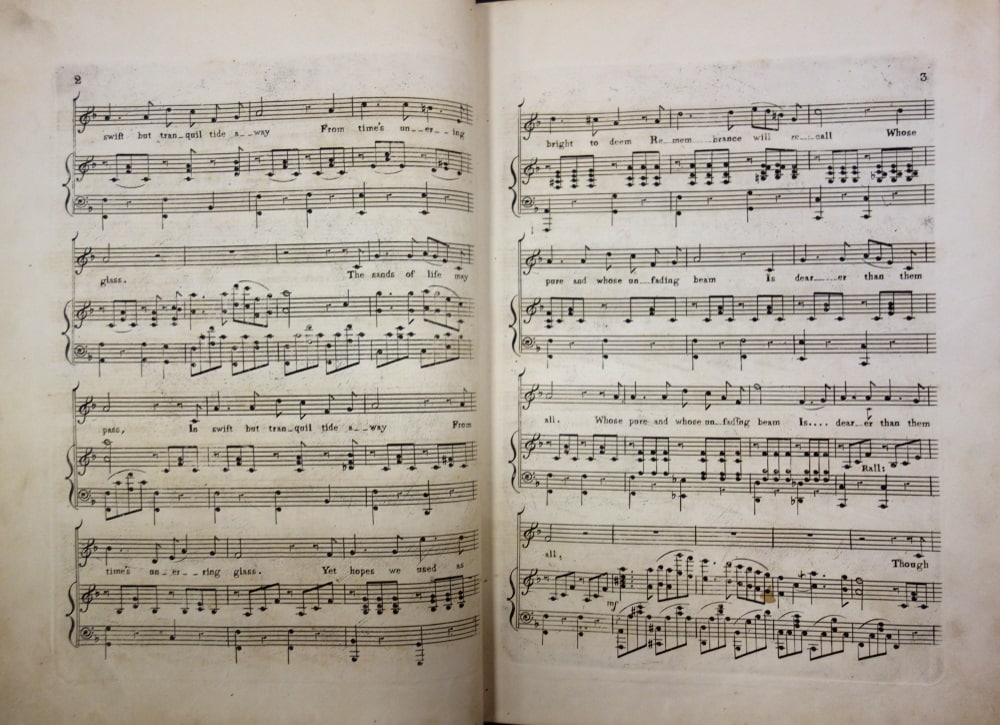
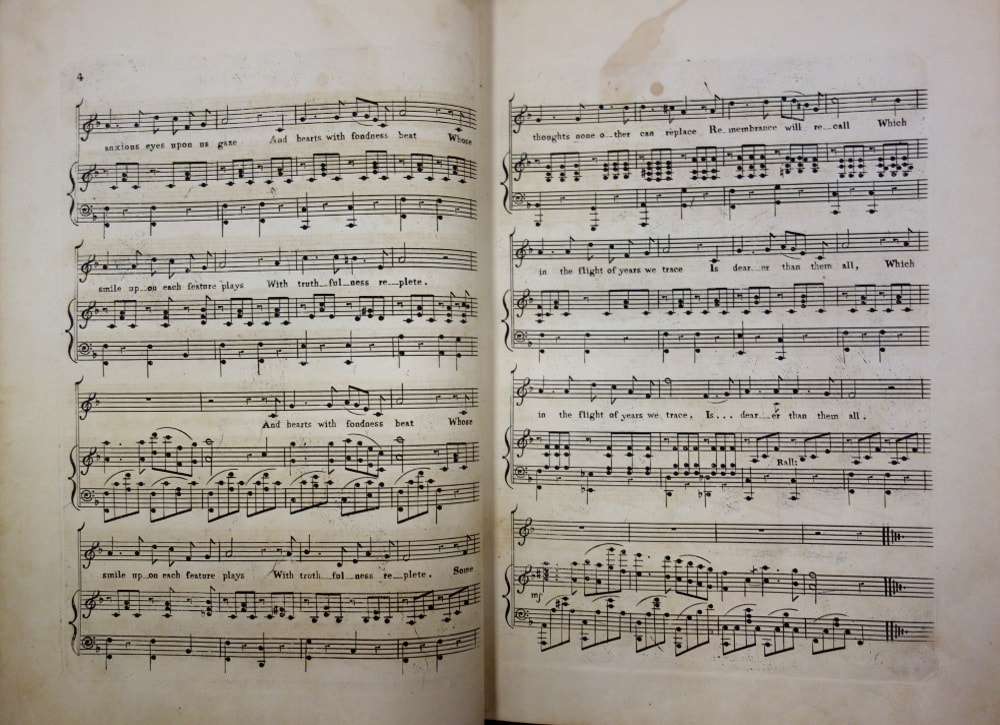
Wallace's opera premiered in London on 15 November 1845, and a review of it was first copied in the Sydney Herald in April 1846. Excepts from the music were first performed in Hobart Town in July, including the overture, played as a piano solo by Leopold Rawack, and the ballad "Scenes that are brightest", sung by Emma Rogers in an adapted production "founded on the celebrated opera" at the theatre. In Sydney on 2 September the composer's brother and sister, Spencer Wallace and Eliza Bushelle gave a concert with four vocal excepts, including "There is a flower that bloometh" (sung by John Howson) and "In happy moments" (sung by Frank Howson). A few days later, Spencer Wallace advertised that he had just published and edition of "In happy moments", nothing that they came with the authentication of his signature, perhaps to mark them out from other imported copies of the song that he believed to be incorrect. This copy does not bear Wallace's signature, but it is likely that it was printed later from the same plates, and probably also under the same original cover.
Hudson advertised in the press only rarely, but this August 1847 advertisement suggests that his "edition" may date from that time.
[Advertisement], The Sydney Morning Herald (23 August 1847), 1
http://nla.gov.au/nla.news-article12894505
JUST PUBLISHED. - The Brecon, Bohemian, and Jullien's original Polkas. Also, the following favourite Songs:- "We may be happy yet" - "The Spell is broken" - "They say there is some distant Land" - "In happy Moments," &c. The above may be had from G. Hudson, music seller, No. 377, Pitt-street North. N.B. - A superior toned Cornopean, by Pask. Also, Fousses' Pianoforte Tutor, Nicholson's Flute Tutor.
Jervis appears to have copied the cover form layout and detail directly from the London edition. However, the musical text does indeed differ very significantly, for example, from this early London edition (Hutchings & Romer), copy at the National Library of Australia
http://nla.gov.au/nla.obj-175884100 (DIGITISED)
WALLACE, William Vincent (music composed)
HUDSON, George (publisher)
JERVIS, Harry Cooper (engraver, cover)
"ENGLISH EXTRACTS. MR. WALLACE'S NEW OPERA OF MARITANA", The Sydney Morning Herald (10 April 1846), 3
http://nla.gov.au/nla.news-article12886456
[Advertisement], The Sydney Morning Herald (2 September 1846), 1
http://nla.gov.au/nla.news-article12899663
[Advertisement], The Sydney Morning Herald (7 September 1846), 1
http://nla.gov.au/nla.news-article12889522
JUST PUBLISHED. MR. WALLACE has the honour to inform his friends, and the public of Sydney, that he has published the admired ballad from his brother's Opera of MARITANA, entitled "In Happy Moments." All copies got up under his inspection will bear his signature, "S. W. Wallace." To be had of Messrs. Grocott, Ford, and Colman, booksellers, George-street; Mr. Moffitt, Pitt street; and Mr. Hudson, musicseller, Pitt street.
4 La militaire quadrilles (Daniell / Wilson / 1848)
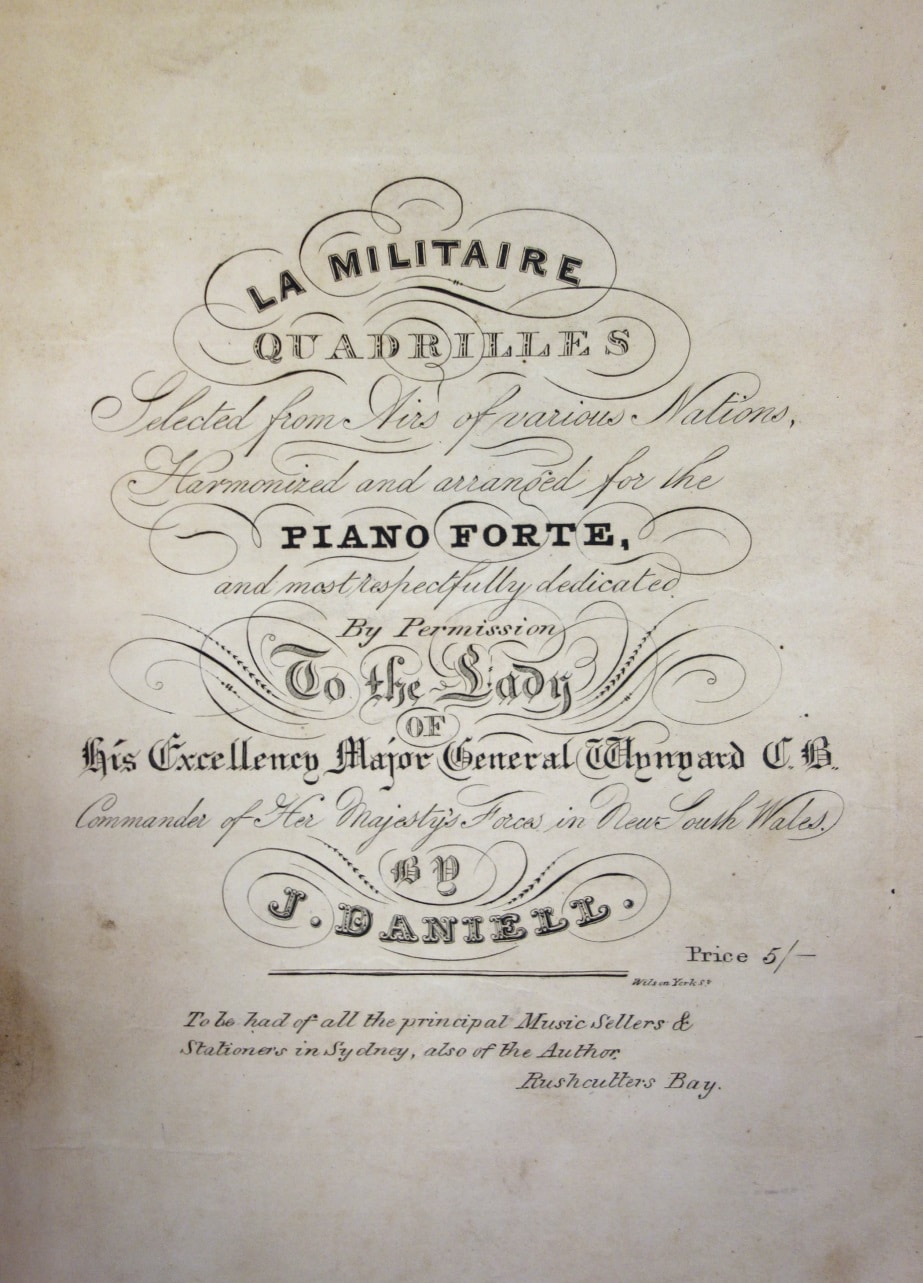
La militaire quadrilles, selected from the airs of various nations harmonized and arranged for the piano forte and most respectfully dedicated by permission to the lady of his excellency Major General Wynyard, C.B., commander of her majesty's forces in New South Wales by J. Daniell
(Rushcutter's Bay: Author, n.d. [1848])
Titlepage (0), "Wilson, York St.", 5 pages music (1-5)
Copy has pencilled fingerings on 2, and an ornament separately notated on 3 [Add images PICTURE]
Another copy at State Library of New South Wales (Q786.4/Mu4)
Photocopy (of the above) at National Library of Australia
http://nla.gov.au/nla.obj-179494672 (DIGITISED)
DANIELL, John Alfred (alias of Alfred HEARNE) (music composed)
WILSON, William (engraver)
"MUSICAL", The Australian (10 March 1848), 3
http://nla.gov.au/nla.news-article37132531
[Advertisement], The Australian (10 March 1848), 1
http://nla.gov.au/nla.news-article37132527
5 By the sad sea waves (Benedict / Grocott / 1850)
Ballad, By the sad sea waves, the words by J. L. Lambert, the music by Jules Benedict, sung by Miss Sarah Flower, on Friday evening, May 3, 1850, at the Royal Victoria Theatre
([Sydney]: Printed and published by J. T. Grocott, music saloon, 486, George Street, [1850])
Titlepage (0), 4 pages music (1-4), publisher's number" "563" ("564" [sic] on 3); pencil alterations to the piano accompaniment on 3, ornamentation for final cadence entered in ink on blank page after 4 [ADD IMAGES]
Another copy of the edition at National Library of Australia
http://nla.gov.au/nla.obj-168981895 (DIGITISED)
FLOWER, Sara (contralto vocalist)
GROCOTT, James Turner (publisher)
Theodosia Stirling (later Guerin) first introduced the ballad "By the sad sea waves", from Jules Benedict's opera The brides of Venice to a Sydney audience in July 1845 (first performed London, April 1844). However, it was Sara Flower, who popularised it on her arrival in 1850, singing it in Melbourne in February and March 1850, and at her Sydney debut, in Stephen and Henry Marsh's concert at the theatre, on 3 May. Grocott first advertised this edition for sale on 18 May 1850.
[Advertisement], The Sydney Morning Herald (18 May 1850), 1
http://nla.gov.au/nla.news-article12918026
"BY THE SAD SEA WAVES." THIS delightful Ballad, as sung by MISS SARA FLOWER, may be had at GROCOTTS Music Saloon. Also, On Monday next Henry Russell's celebrated Song, "THE OLD ARM CHAIR."
6 Tell him I love him yet (Stanley / Grocott / 1850)
Tell him I love him yet, ballad, the music by William Stanley, sung by Miss Sara Flower with much applause at the Sydney concerts
(Sydney: Printed and published for Mr. Stanley by J. T. Grocott, n.d. [1850])
Edition first advertised 28 June 1850
Titlepage (0), inscribed in pen: "No. 60", "W. Stanley" [? stamp]; "With the Author's Compts."; 6 pages music (1-6), publisher's number: "601"; vocal ornamentation added in ink on most pages
Another copy ("no. 27") at the National Library of Australia
http://nla.gov.au/nla.obj-181784586 (DIGITISED)
STANLEY, William (music composed)
FLOWER, Sara (contralto vocalist)
GROCOTT, James Turner (publisher)
[Advertisement], The Sydney Morning Herald (4 June 1850), 1
http://nla.gov.au/nla.news-article12918412
[Advertisement], The Sydney Morning Herald (21 June 1850), 3
http://nla.gov.au/nla.news-article12918940
[Advertisement], The Sydney Morning Herald (28 June 1850), 1
http://nla.gov.au/nla.news-article12919100
7 Devonshire polka ([Oury] / Hudson / c.1850)
No. [blank] of a selection of favourite polka arranged for the piano forte by Jullien &c &c
Sydney: Published by G. Hudson, 377 Pitt St. North, n.d. [c. )
Devonshire polka [page 1]
Series cover (0), 1 page music; no added markings
Another copy of this edition at State Library of New South Wales
http://archival-classic.sl.nsw.gov.au/album/albumView.aspx?itemID=917398&acmsid=0 (DIGITISED)
Among all the Sydney publishers of the later 1840s, Hudson, who was also master of the City Band and who also frequently appeared in the theatre band, was the most prolific in issuing local editions of polkas, as indeed also noted publicly for playing them. Almost all of his polka editions were issued under an identical cover page, with an increasingly incomplete list of only the first twelve titles at the bottom of the page. Hudson rarely advertised in the press, but he did so when he began his own polka series in 1847, thus providing some local chronology at least to the early titles.
[Advertisement], The Sydney Morning Herald (23 August 1847), 1
http://nla.gov.au/nla.news-article12894505
JUST PUBLISHED. - The Brecon, Bohemian, and Jullien's original Polkas. Also, the following favourite Songs:- "We may be happy yet" - "The Spell is broken" - "They say there is some distant Land" - "In happy Moments," &c. The above may be had from G. Hudson, music seller, No. 377, Pitt-street North. N.B. - A superior toned Cornopean, by Pask. Also, Fousses' Pianoforte Tutor, Nicholson's Flute Tutor.
HUDSON, George (publisher)
The Devonshire polka by the pianist Anna Caroline Oury (1808-1880) appeared in an edition by Cramer, Beale and Co., around 1848, and the title was advertised for sale at Chester, in the homeland British provinces, in 1849.
[Advertisement], The stranger's companion in Chester (Chester: Catherall, 1849), 131
https://books.google.com.au/books?id=SshDAQAAMAAJ&pg=PA131
See also slightly later extended Woolcott and Clarke edition (1851-56), copy at National Library of Australia
http://nla.gov.au/nla.obj-168371651 (DIGITISED)
8 The drum polka (Jullien / Grocott / c.1850)
A selection of favorite polkas, arranged for the piano forte, by Jullien, & c. [with list of 36 titles: . . . "30. Drum" . . .]
(Sydney: Published by J. T. Grocott, 486, George Street, n.d. [c.1850])
The drum polka, Jullien (title on [2])
Series cover page ([1]), 2 pages music ([2-3]); no added markings
Another copy of the same edition [but cover with list of 50 titles] at National Library of Australia
http://nla.gov.au/nla.obj-165680189 (DIGITISED)
Another copy with incomplete cover page at National Library of Australia
http://nla.gov.au/nla.obj-169698814
[Advertisement], The Sydney Morning Herald (31 August 1850), 1
http://nla.gov.au/nla.news-article12920685
CATALOGUE OF MUSIC AT GROCOTT'S . . . POLKAS [112-147] . . . 141 Drum . . .
Jullien released his own edition of the Drum polka in 1848; see British Library
9 Will you love me then as now ([Glover] / Hudson / 1849)
Will you love me then as now?
(Sydney: Published by G. Hudson, music-seller, 377, Pitt Street, n.d. [1849])
Titlepage (0), 5 pages music (1-5); with pencilled vocal ornaments added; note (? engraver's) stamp "W" at left foot of 5
Copy of same edition, with same cover, at National Library of Australia
http://nla.gov.au/nla.obj-166656699 (DIGITSED)
Copy of same edition, with different cover, at National Library of Australia
http://nla.gov.au/nla.obj-165707984 (DIGITISED)
HUDSON, George (publisher)
CARANDINI, Maria (vocalist)
"MUSIC", Bell's Life in Sydney and Sporting Reviewer (20 January 1849), 2
http://nla.gov.au/nla.news-article59768377
The charming little ballad, "Will you love me then as now?" so effectively sung by Madame Carandini, at the Victoria Theatre, has been published by Mr. G. Hudson, music-seller, Pitt-street. It is got up in excellent style, and the thanks of the public are due to Mr. Hudson for having dashed into the speculation of music publishing for their convenience, in a time of unparalelled gloom and depression.
Compare also slightly later Woolcott and Clarke edition, from different plates, copy at National Library of Australia
http://nla.gov.au/nla.obj-169650221 (DIGITISED)
10 The old arm chair (Russell / Grocott / 1850)
The old arm chair: the words by Miss Eliza Cook, the music by Henry Russell, sing by Miss Sara Flower, at the Royal Hotel, Sydney
([Sydney]: To be had at Grocott's Music Saloon, 486, George Street, n.d. [1850])
Titlepage (0), 5 pages (1-5), publisher's number "566"; added vocal ornaments and alterations to piano part
Copy of same edition, with same cover, at National Library of Australia
http://nla.gov.au/nla.obj-166205507 (DIGITISED)
Another copy of same edition, with different cover, at National Library of Australia
http://nla.gov.au/nla.obj-169248121 (DIGITISED)
FLOWER, Sara (contralto vocalist)
GROCOTT, James Turner (publisher)
[Advertisement], The Sydney Morning Herald (18 May 1850), 1
http://nla.gov.au/nla.news-article12918026
"BY THE SAD SEA WAVES." THIS delightful Ballad, as sung by MISS SARA FLOWER, may be had at GROCOTTS Music Saloon. Also, On Monday next Henry Russell's celebrated Song, "THE OLD ARM CHAIR."
Another later edition, by Henry Marsh, using the same plates, at National Library of Australia
http://nla.gov.au/nla.obj-166202521
11 Polka des voyageurs ([? Wallerstein] / Grocott / c.1850-51)
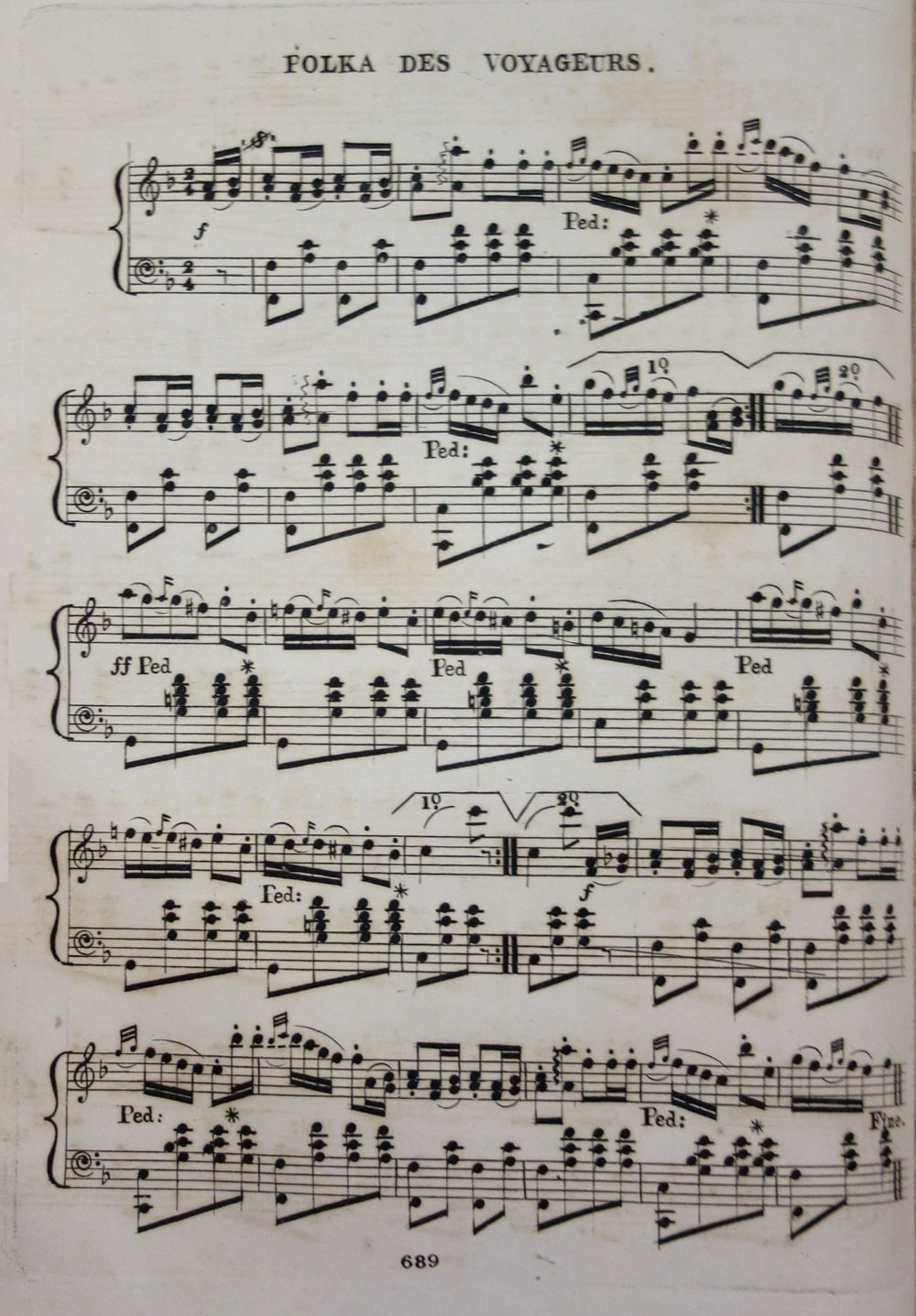
A selection of favorite polkas, arranged for the piano forte, by Jullien, & c. [with list of 36 titles]
(Sydney: Published by J. T. Grocott, 486, George Street, n.d. [c. 1850-51])
Polka des voyageurs (title on [2])
Series cover ([1]), 2 pages music ([2-3]); publisher's number "689"
NO OTHER COPY OF THIS EDITION IDENTIFIED
This title does not appear in the list of polkas in Grocott's catalogue of August 1850 (see above), nor in the updated list of 50 on his later series covers. This edition is ultimately undatable with certainty, though a date in late 1850 or early 1851 seems likely.
GROCOTT, James Turner (publisher)
12 The national schottische ([Anonymous] / Musical Bouquet 189 / 1849)
The national schottische, the new fashionable German dance
([London]: Musical Bouquet no. 189, n.d. [1849])
4 pages music (83-86)
See no. 189 (1849)
http://www.musicalbouquet.co.uk/the-catalogue
13 The rataplan (Donizetti / Musical Bouquet 197 / 1849)
The rataplan, sung by Jenny Lind in Donizetti's opera "La fille du regiment"
([London]: Musical Bouquet no. 197, n.d. [1849])
4 pages music (17-20)
See no. 197 (1849)
http://www.musicalbouquet.co.uk/the-catalogue
14 The bird of passage (Glover / Kern and Mader / ? c.1850)
Flowers of song: by the most eminent composers, arranged for the piano forte, No. 1: The bird of passage, "Spirit of summer, away! away!"
(Sydney: Published only by Messrs. Kern and Mader, music sellers and stationers, 7, Hunter-street, n.d.)
Titlepage (0), 6 pages music (1-6); no added markings
NO OTHER COPY OF THIS EDITION IDENTIFIED
KERN, Charles (publisher)
MADER, Frederick (publisher)
Both this series and this title are previously unknown, and were not advertised. The few of Kern and Mader's musical editions that have been identified date from 1853, the last year of their partnership, and are Isaac Nathan titles, typeset by the composer. This is the only engraved music print appearing under their cover.
15 Di tanti palpiti with variations (Rossini-Dale / Duncombe / c.1840)
Di tanti palpiti, a favorite air [from "Tancredi"], composed by Rossini, arranged with variations for the piano forte by J. Dale
(London: Pubd. by Duncombe, music seller, 10, Middle R., n.d. [c.1840])
4 pages music (1-4)
16 When we two parted (Nathan / Cramer, Addison, and Beale, &c. / 1837)
"When we two parted"; poet, Lord Byron; composer, I. Nathan
(London: Cramer, Addison, and Beale . . . ; Joseph Thomas . . .; J. A. Novello . . ., n.d. [1837])
Titlepage (1), 4 pages music (3-6)
Another copy of the same edition at National Library of Australia
http://nla.gov.au/nla.obj-174927034 (DIGITISED)
[Advertisement], The spectator (24 June 1837), 599
https://books.google.com.au/books?id=5zA_AQAAIAAJ&pg=PA599
NEW SONGS. - MALIBRAN'S FAREWELL TO AMERICA, Written and Sung by Herself, on the Eve of her Departure for Europe. Also, QUEEN OF EVENING. The last Composition she received in this Country from the hands of her Biographer. And a NEW EDITION of Lord Byron's admired "WHEN WE TWO PARTED." Composer, J. NATHAN. Price 2s. each. London: CRAMER, ADDISON, and BEALE; J. A. NOVELLO; and JOSEPH THOMAS.
17 The aurora waltz (Labitzky / Musical Bouquet 62-63 / 1846)
The aurora waltz par Labitzky
(London: Musical Bouquet nos. 62-63, n.d. [1846])
? pages music (?-60)
See no. 62-63 (62d) (1846)
http://www.musicalbouquet.co.uk/the-catalogue
18 I speak not, I trace not, I breathe not thy name [from Hebrew melodies no. 4] (Nathan / Falkner / 1829 offprint)
I speak not, I trace not, I breathe not thy name; poet, Lord Byron; composer, I. Nathan
(London: Falkner, 3, Old Bond Street, n.d. [1829 offprint])
6 pages music (201-206); added vocal ornaments in two hands
This is an offprint from Falkner's original edition of A selection of Hebrew melodies . . . fourth number, using the original plates, but with the publisher's details tipped in under the title heading; see copy of the original at National Library of Australia
http://nla.gov.au/nla.obj-171443782/view?partId=nla.obj-171467223#page/n213/mode/1up (DIGITISED)
19 Queen of evening (Nathan / Cramer, Addison, and Beale, &c. / 1837)
"Queen of evening"; port Maurice Harcourt; one of the favoured ballads mentioned in her memoirs by her biographer, the composer, I. Nathan
(London: Cramer, Addison, and Beale . . . ; Joseph Thomas . . .; J. A. Novello . . ., n.d. [1837])
Titlepage (1), 4 pages music (3-6)
Another copy of the same edition at National Library of Australia
http://nla.gov.au/nla.obj-171438340 (DIGITISED)
[Advertisement], The spectator (24 June 1837), 599
https://books.google.com.au/books?id=5zA_AQAAIAAJ&pg=PA599
NEW SONGS. - MALIBRAN'S FAREWELL TO AMERICA, Written and Sung by Herself, on the Eve of her Departure for Europe. Also, QUEEN OF EVENING. The last Composition she received in this Country from the hands of her Biographer. And a NEW EDITION of Lord Byron's admired "WHEN WE TWO PARTED." Composer, J. NATHAN. Price 2s. each. London: CRAMER, ADDISON, and BEALE; J. A. NOVELLO; and JOSEPH THOMAS.
20 The Sydney Corporation quadrilles (Ellard / Ellard / 1842)
The Sydney Corporation quadrilles, dedicated by permission to Mrs. John Hosking, composed by Frederick Ellard
(Sydney: Published by F. Ellard, music seller, George Street, n.d. [1842])
Titlepage (0), 5 pages music (1-5); titlepage engraving signed "Carmichael Sc."
Another copy at the National Library of Australia
http://nla.gov.au/nla.obj-165404774 (DIGITISED)
ELLARD, Frederick (music composed)
ELLARD, Francis (publisher)
HOSKING, Martha (Mrs. John HOSKING) (dedicatee, first mayoress of Sydney)
CARMICHAEL, John (cover engraver)
"NEW MUSIC", The Australian (16 December 1842), 2
http://nla.gov.au/nla.news-article37117194
21 Les etoilles quadrilles (Dos Santos / Rolfe / 1843)
Dos Santos's 5th set of original quadrilles, Les etoilles, arranged for the piano forte by A. C. Whitcombe
(Sydney: Published by T. Rolfe, Hunter Street, n.d. [1843])
Titlepage (0): "H. C. Jervis, Sc."; 5 pages music (1-5)
NO OTHER COPY OF THIS EDITION YET IDENTIFIED
(Neidorf 1999, 228, listed one otherwise unidentified Rolfe print of a Dos Santos/Whitcombe title, whereabouts not indicated)
ASSOCIATIONS: Thomas Rolfe (publisher); Harry Cooper Jervis (engraver)
Thomas Rolfe advertised this set of quadrilles by Duarte Joaquim Dos Santos for sale in October 1843:
[Advertisement], The Sydney Morning Herald (16 October 1843), 3
http://nla.gov.au/nla.news-article12423097
MUSIC AT HALF PRICE. JULLIEN'S Nightingale Waltzes, and Quadrilles from Auber's Opera "Le Fiance." Dos Santos's Quadrilles, "Les Etoiles," "Les Portugaises," "Les Pappillons." Pianos tuned for 5s. ROLFE, Hunter-street.
22 La reine d'ocean quadrilles (Dos Santos / Rolfe / c. 1844-45)
New series, Dos Santos's 3rd set of original quadrilles, La reine d'ocean, arranged for one performer on the piano forte, by A. C. Whitcombe
(Sydney: Published by T. Rolfe, George Street, n.d. [c. 1844-45])
Titlepage (0); 5 pages music (1-5)
NO OTHER COPY OF THIS EDITION YET IDENTIFIED
(Neidorf 1999, 228, listed one otherwise unidentified Rolfe print of a Dos Santos/Whitcombe title, whereabouts not indicated)
ROLFE, Thomas (publisher)
Rolfe was trading from George Street during 1844 and into 1845.
23 Les Portugaises quadrilles (Dos Santos / Rolfe / 1843)
New series, Les Portugaises, 2nd set of original quadrilles and a waltz, for the piano forte, composed by J. Duarte Dos Santos
(Sydney: Published by T. Rolfe, Hunter Street, n.d. [1843])
Titlepage (0); 6 pages music (2-7)
NO OTHER COPY OF THIS EDITION YET IDENTIFIED
(Neidorf 1999, 228, listed one otherwise unidentified Rolfe print of a Dos Santos/Whitcombe title, whereabouts not indicated)
ASSOCIATIONS: Thomas Rolfe (publisher)
Thomas Rolfe advertised this set of quadrilles by Duarte Joaquim Dos Santos for sale in October 1843:
[Advertisement], The Sydney Morning Herald (16 October 1843), 3
http://nla.gov.au/nla.news-article12423097
MUSIC AT HALF PRICE. JULLIEN'S Nightingale Waltzes, and Quadrilles from Auber's Opera "Le Fiance." Dos Santos's Quadrilles, "Les Etoiles," "Les Portugaises," "Les Pappillons." Pianos tuned for 5s. ROLFE, Hunter-street.
24 Ada (Nathan / [? Fentum] / c. 1820s)
Ada, the poetry by the rt. honble Lord Byron, the music by I. Nathan
([London: ? Fentum, c. 1820s])
4 pages music (1-4)
Another copy of the same original edition at National Library of Australia
http://nla.gov.au/nla.obj-166001061 (DIGITISED)
25 The nameless grave (Nathan / Fentum / c.1820s)
The nameless grave, written by Susanna Strickland, in Cove church-yard, and occasioned by observing her own shadow thrown across a grave; composed by I. Nathan
(London: Published for the author by M. A. Fentum, 73, Strand, n.d. [?1820s])
Titlepage (1), 4 pages music (2-5)
Another copy of the same original edition at National Library of Australia
http://nla.gov.au/nla.obj-174923177 (DIGITISED)
26 How sad to live (Nathan / Fentum / c. 1820s)
How sad to live, the poetry by Maurice Harcourt esqre., the music by I. Nathan
(London: M. A. Fentum, 73, Strand, n.d. [?1820s])
Titlepage (0), 5 pages music (1-5)
Another copy of the same original edition at National Library of Australia
http://nla.gov.au/nla.obj-171437663 (DIGITISED)
27 Overture The magic flute (Mozart / Dale / c.1820s)
Mozart's overtures for the piano forte no. [blank] [series cover, list of 7 numbers]
(London: Published by W. Dale, 19, Poultry, n.d. [before 1828])
Overture, by Mozart [page 2]
Cover page (1), 6 pages music (2-7)
NO OTHER COPY OF THIS EDITION YET IDENTIFIED
28 Rondo from Symphony in C [no. 1] (Beethoven / Dale / c. 1820s)
A favorite selection of music for the piano forte by Beethoven no. [blank] [series cover]
(London: Published by W. Dale, 19, Poultry, n.d. [before 1828])
Beethoven's rondo, from his grand sinfonia, in C [page 1]
Cover page (0), 5 pages music (1-5)
NO OTHER COPY OF THIS EDITION YET IDENTIFIED
29 The bells of St. Petersburgh with variations (Gelinek / Dale / c.1820s)
A favourite air, with variations for the piano forte, composed by Gelinek, no. [blank]
(London: Published by W. Dale, 19, Poultry, n.d. [before 1828])
The bells of St. Petersburgh [page 2]
Cover page (1), 6 pages music (2-7)
NO OTHER COPY OF THIS EDITION YET IDENTIFIED; the British Library has copies of a Goulding & D'Almaine edition
30 Lady O'Connell's waltz (Stubbs / Jervis)
Lady O'Connell's waltz, composed and most respectfully dedicated to her ladyship, by her ladyship's very humble servant, T. Stubbs
(Sydney: Engraved, printed & published H. C. Jervis, Pitt St. N., n.d. [1845])
Titlepage, 2 pages music
Another copy at State Library of New South Wales
http://archival-classic.sl.nsw.gov.au/album/albumView.aspx?itemID=917483&acmsid=0 (DIGITISED)
STUBBS, Thomas (music composed)
NATHAN, Isaac (music arranged)
JERVIS, Harry Cooper (engraved, printed, published)
O'CONNELL, Mary (patron, dedicatee)
"NEW MUSIC", Morning Chronicle (17 September 1845), 3
http://nla.gov.au/nla.news-article31746343
[Letter] "To the Editors", The Sydney Morning Herald (23 September 1845), 3
http://nla.gov.au/nla.news-article12882346
To the Editors of the Sydney Morning Herald. GENTLEMEN, - In your kind notice of my composition of Lady O'Connell's Waltz: the merit of its arrangement is due to the kindness of Mr. Nathan, the Waltz or Melody alone being that of Your very humble, And very obliged servant. THOMAS STUBBS. September 22.
31 Sir Wilfred (Nathan / Baker / 1845)
Sir Wilfred, the much admired romance, sung by Mrs. Ximenes, in the very successful tragic play produced at the Victoria Theatre, Sydney, entitled "The queen's love"; author David Burn, esq.; composer I. Nathan, esq.
(Sydney: Published by W. Baker, 101, King-street, n.d. [1845])
6 pages music (1-6), typeset by Nathan
Another copy at the National Library of Australia
http://nla.gov.au/nla.obj-165999029 (DIGITISED)
NATHAN, Isaac (music composed)
BURN, David (words)
BAKER, William (publisher)
XIMENES, Anne = Anne WINSTANLEY (composed for)
First performance:
"ROYAL VICTORIA THEATRE", The Sydney Morning Herald (29 September 1845), 2
http://nla.gov.au/nla.news-article12882472
ROYAL VICTORIA THEATRE. This EVENING, SEPTEMBER 29, WILL be produced, with new scenery, dresses, decorations, and music, the new Historical Tragic Play, in 6 Acts, from the pen of David Burn, Esq., (Member of the Dramatic Authors' Society,) entitled THE QUEEN'S LOVE, Preceded by a Prologue, written for the occasion, and to be spoken by Mrs. O'Flaherty . . . In the course of the Piece, Mrs. Ximenes will sing an olden Romance, called Sir Wilfred he mounted his War-steed true. The Melody and Orchestral Accompaniments written and arranged expressly for the Tragedy, by J. Nathan, Esq.
Publication:
[Advertisement], The Australian (29 November 1845), 2
http://nla.gov.au/nla.news-article37154100
32 Why are you wandering (Nathan / [Fentum])
Why are you wandering
5 pages music (1-5)
[Titlepage missing]
([London: J. Fentum, [original edition 1823; ? later reprint "edition"])
Copy of the same original plates ("twelfth edition"), with titlepage, at National Library of Australia
http://nla.gov.au/nla.obj-178361742 (DIGITISED)
Another copy from the same plates ("fifteenth edition", Goulding, D'Almaine & Co.), with titlepage, at National Library of Australia
http://nla.gov.au/nla.obj-168431914 (DIGITISED)
33 The lady-bird (Nathan / Falkner / 1831)
The lady-bird, composer, I. Nathan
(London: Published by H. Falkner, 3, Old Bond Street, n.d. [1831])
6 pages music (1-6), full orchestral score
Another copy from the same original edition at National Library of Australia
http://nla.gov.au/nla.obj-174924420 (DIGITISED)
"NEW PUBLICATIONS", The Athenaeum (27 August 1831), 556
https://books.google.com.au/books?id=x1owAQAAMAAJ&pg=PA556
34 Bright be the place of thy soul (Nathan / Fentum / after c.1815)
Bright be the place of thy soul, the poetry by the rt. honble. Lord Byron, composed by I. Nathan
(London: Published by J. Fentum, 78, Strand, n.d. [original edition c.1815; ? later reprint])
Titlepage (0), 5 pages music (1-5), advertisement on 6
Another copy of the same edition at National Library of Australia
http://nla.gov.au/nla.obj-166001525 (DIGITISED)
35 Royal Irish quadrilles (2nd set) (Jullien / Rolfe)
Second set of Royal Irish quadrilles, composed and dedicated to his friend Mons. T. Chap of Liverpool, by Jullien; these quadrilles were composed expressly for the Dublin Promenade Concerts and performed nightly with the greatest success by the author & his inimitable band
(Sydney: Published by T. Rolfe, music seller, George Street, n.d)
Titlepage (0) "J. Carmichael, Sc. Sydney", 6 pages music (1-6)
NO OTHER COPY OF THIS EDITION IDENTIFIED
ROLFE, Thomas (publisher)
CARMICHAEL, John (engraver, cover)
36 I lov'd thee not (Black / Clementi, Collard & Collard/ c. 1820s)
I lov'd thee not, an admired canzonet, composed with an accompaniment for the piano forte, by Geo: Black
(London: Published by Clementi, Collard & Collard, 26. Cheapside, n.d. [ ])
4 pages music (1-4)
NO OTHER COPY YET IDENTIFIED
Bibliography and resources
B. W. Strong, P. Young, C. H. Strong, The direct descendants of Henry & Mary Ann Strong ([Deniliquin]: Deniliquin Newspapers, [? 2011])
https://trove.nla.gov.au/version/172681913
© Graeme Skinner 2014 - 2025